Rainbow Wounding
Rainbow Wounding is a Free Peoples deck most commonly seen in Movie Block. It uses direct wounding cards from a variety of cultures, often supplemented with a single strong tank companion or archery wounds. There are so many good direct wounding strategies in this format that it's mainly a matter of choosing which ones to use. The deck just needs two things: companions that wound minions, and some way to heal them. This isn't one deck so much as a catch-all for a handful of similar decks that are all hybrids of each other, and many of these strategies can and are often incorporated into other decks. Despite the variety, there are a handful of core cards that appear consistently in different versions of this deck: Legolas, Greenleaf (1R50)
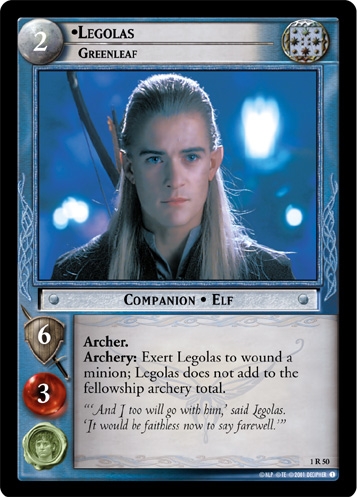 , Éowyn, Lady of Ithilien (10R72)
, Éowyn, Lady of Ithilien (10R72)
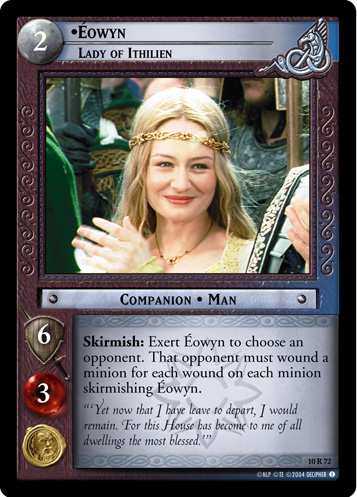 , and Sméagol, Always Helps (7R71)
, and Sméagol, Always Helps (7R71)
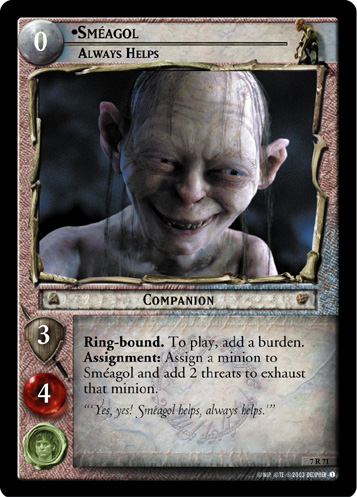 .
.
The core plan is to kill minions off before their skirmishes resolve. This can mean softening them up with Slaked Thirsts (7U14)
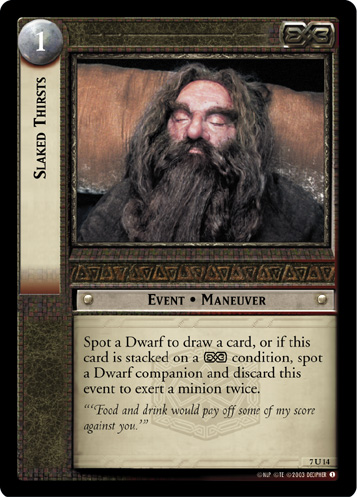 , then finishing them off with Legolas, Greenleaf (1R50)
, then finishing them off with Legolas, Greenleaf (1R50)
 . Or softening up a high-vitality minion with Greenleaf then skirmishing that minion with Éowyn, Lady of Ithilien (10R72)
. Or softening up a high-vitality minion with Greenleaf then skirmishing that minion with Éowyn, Lady of Ithilien (10R72)
 to wipe out many minions at once with her ability. It can happen entirely in the skirmish phase, with Smeagol, Always Hopes
to wipe out many minions at once with her ability. It can happen entirely in the skirmish phase, with Smeagol, Always Hopes
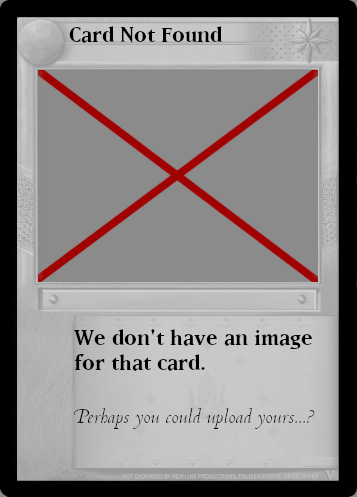 exhausting a minion then finishing it off with Don’t Look at Them (6R39)
exhausting a minion then finishing it off with Don’t Look at Them (6R39)
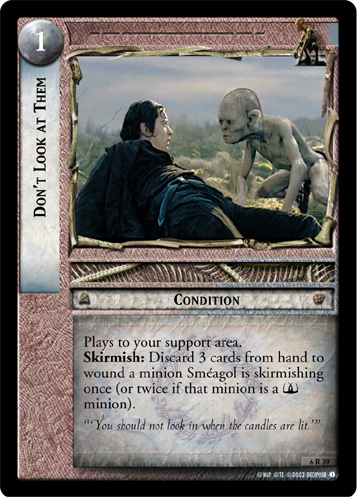 . Or it can even happen in the Shadow Phase, with one or more Shadowplay (10U114)
. Or it can even happen in the Shadow Phase, with one or more Shadowplay (10U114)
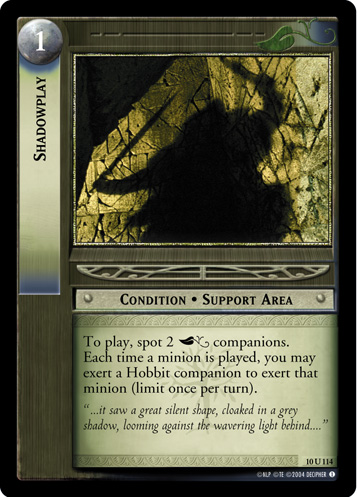 activations followed by an Unheeded (8R115)
activations followed by an Unheeded (8R115)
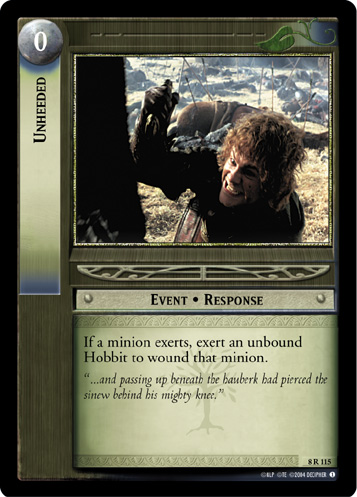 finisher. Oftentimes, if a minion is dangerous because of an exertion ability rather than because of its strength in a skirmish, just exerting it first can be enough.
finisher. Oftentimes, if a minion is dangerous because of an exertion ability rather than because of its strength in a skirmish, just exerting it first can be enough.
This gameplan is risky. If minions are too tough or numerous to kill with direct wounds, or simply immune, then you may be left scrambling to deal with them with low-strength, often-exhausted companions. But once it gets rolling, it makes double moves very efficiently, since all of the minions are dead! It also very effectively shuts down many strategies that use one minion to buff another, or rely on spotting a minion in play to execute some sort of strategy. Plus, if a minion is dead, who cares what its strength was?
The deck also often makes use of the initiative conditions from Mount Doom: Hardy Garrison (10U33)
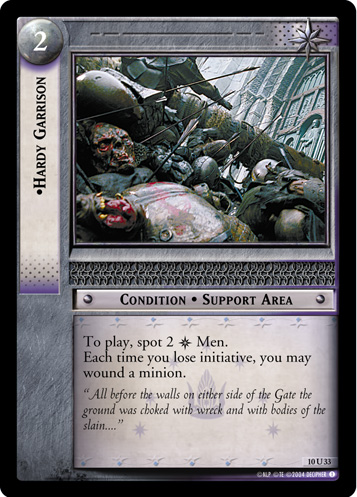 , A Light in His Mind (10U108)
, A Light in His Mind (10U108)
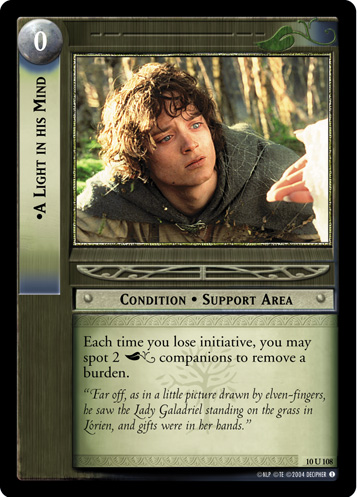 , Glimpse of Fate (10U12)
, Glimpse of Fate (10U12)
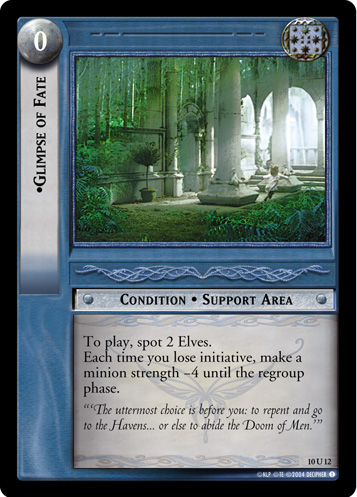 , and sometimes Brooding on Tomorrow (10U15)
, and sometimes Brooding on Tomorrow (10U15)
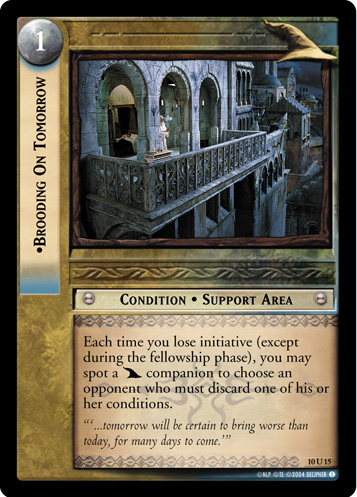 .
.
Greenleaf and Elven Support[edit]

Legolas, Greenleaf (1R50)
 is a powerful card just on his base ability. He's always good for at least one wound, and he can pick off troublesome two-vitality characters on his own with no support. Give him cards that increase his vitality, like The Tale of Gil-galad (1R66)
is a powerful card just on his base ability. He's always good for at least one wound, and he can pick off troublesome two-vitality characters on his own with no support. Give him cards that increase his vitality, like The Tale of Gil-galad (1R66)
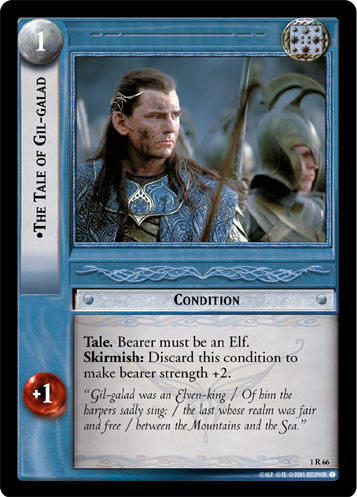 or Aiglos (9R+12)
or Aiglos (9R+12)
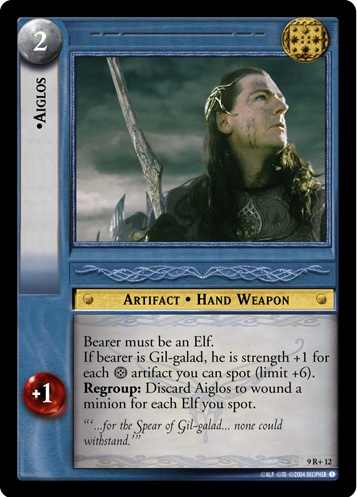 , and he can handle even larger minions. You don't have to stop there; he can be supported with a larger Elven
, and he can handle even larger minions. You don't have to stop there; he can be supported with a larger Elven
 contingent.
contingent.
Elves have powerful, splashable healing to enable Greenleaf or other companions. Elrond, Herald to Gil-galad (3R13)
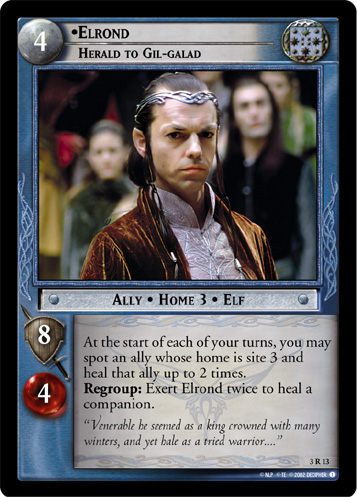 can fit into any deck, and opens up the possibility of including strong condition removal like Vilya (3R27)
can fit into any deck, and opens up the possibility of including strong condition removal like Vilya (3R27)
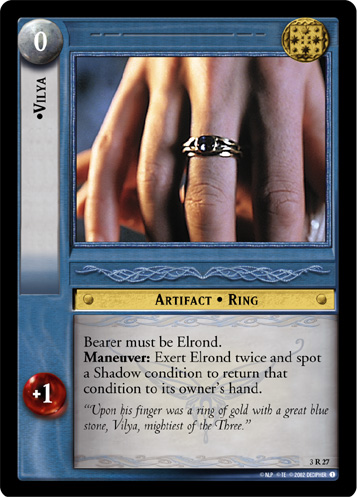 or Secret Sentinels (2R20)
or Secret Sentinels (2R20)
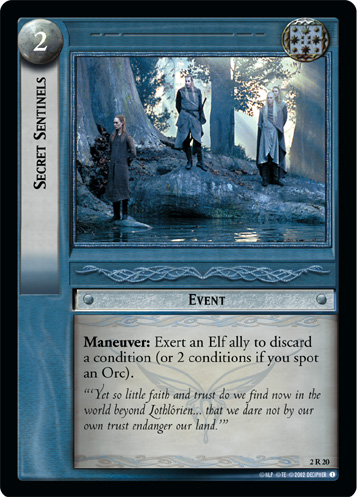 .
. Elven culture has even more healing options that work only on elves, like the strong cycling tool Shadow Between (7R28)
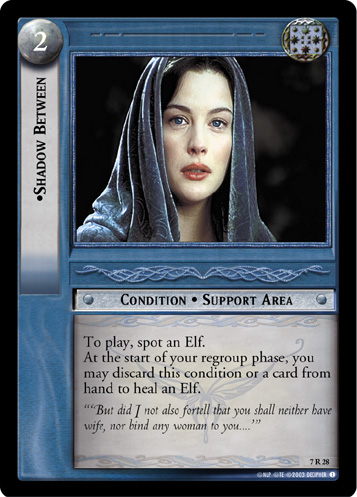 . If your deck has a dwarf like Gimli, Bearer of Grudges (9R+4)
. If your deck has a dwarf like Gimli, Bearer of Grudges (9R+4)
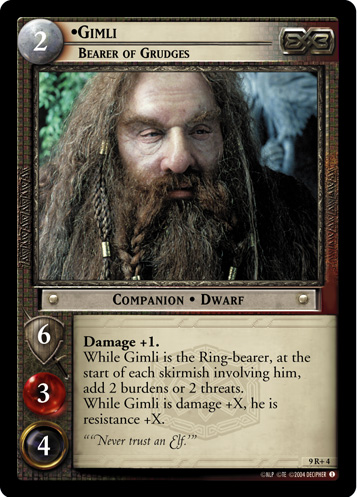 , you can also transfer wounds off of Greenleaf with Shoulder to Shoulder (1C59)
, you can also transfer wounds off of Greenleaf with Shoulder to Shoulder (1C59)
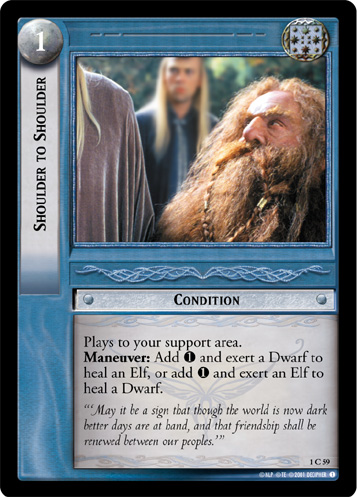 , often to allies like Herald to Gil-Galad. If you're running Shoulder to Shoulder already, then Elven
, often to allies like Herald to Gil-Galad. If you're running Shoulder to Shoulder already, then Elven
 allies like Rúmil, Elven Protector (1U57)
allies like Rúmil, Elven Protector (1U57)
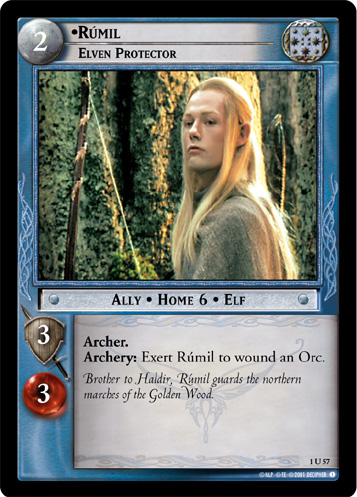 or maybe Orophin, Lorien Bowman (1U56)
or maybe Orophin, Lorien Bowman (1U56)
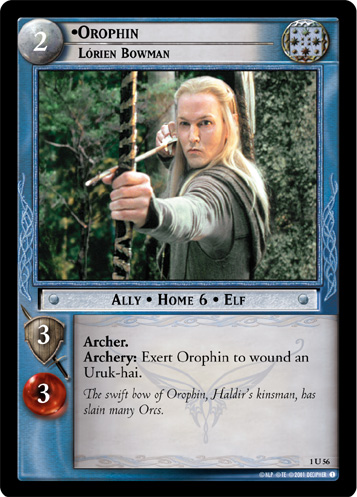 become more attractive. If you can't use their abilities because of your opponent's Shadow deck, then just use them as wound batteries!
become more attractive. If you can't use their abilities because of your opponent's Shadow deck, then just use them as wound batteries!
Greenleaf also has a Frodo signet, so you can defend him in a skirmish with some of the Frodo signet events discussed below, like Mind Your Own Affairs (4U312)
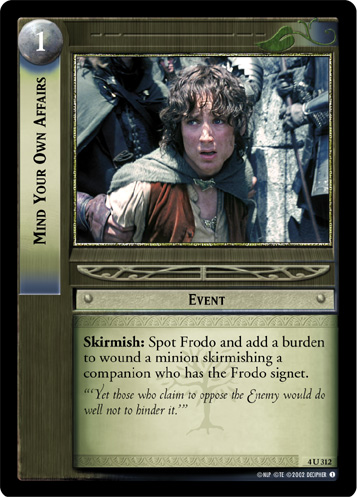 and No Use That Way (5R113)
and No Use That Way (5R113)
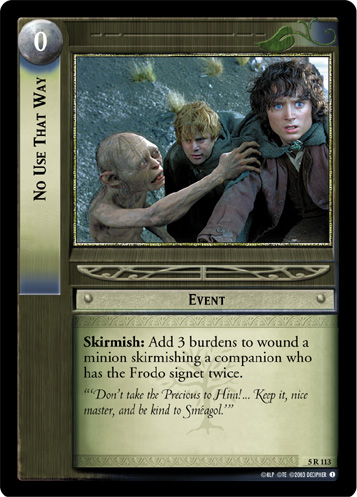 . If you're doing that, then Bow of the Galadhrim (1R33)
. If you're doing that, then Bow of the Galadhrim (1R33)
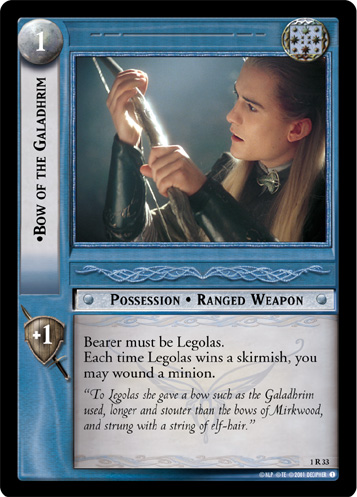 may be an option: if you kill the minion Legolas is skirmishing with a skirmish event, then you can wound another minion in another skirmish too.
may be an option: if you kill the minion Legolas is skirmishing with a skirmish event, then you can wound another minion in another skirmish too.
Legolas can use Double Shot (1R38)
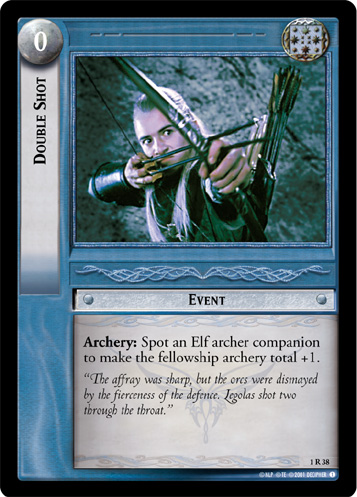 to get an additional undirected wound, but most of the other
to get an additional undirected wound, but most of the other Elven archery cards have too much cultural enforcement to work in a rainbow deck. He's terrible at using The Splendor of Their Banners (1R62)
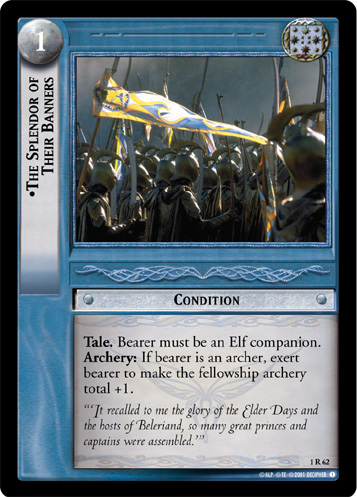 since it conflicts with his inherent exertion ability, and you need a lot of elf companions for cards like Elven Bow (1C41)
since it conflicts with his inherent exertion ability, and you need a lot of elf companions for cards like Elven Bow (1C41)
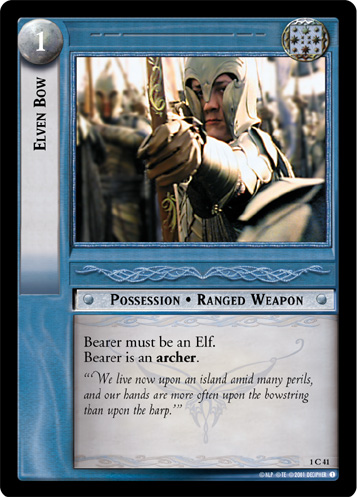 or Break the Charge (5R11)
or Break the Charge (5R11)
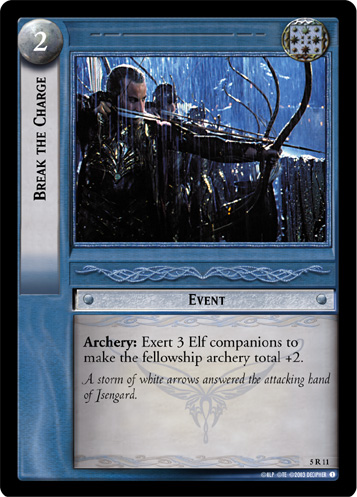 . There are other versions of Legolas that can use Splendor effectively in a rainbow deck, like Legolas, Fearless Marksman (7R25)
. There are other versions of Legolas that can use Splendor effectively in a rainbow deck, like Legolas, Fearless Marksman (7R25)
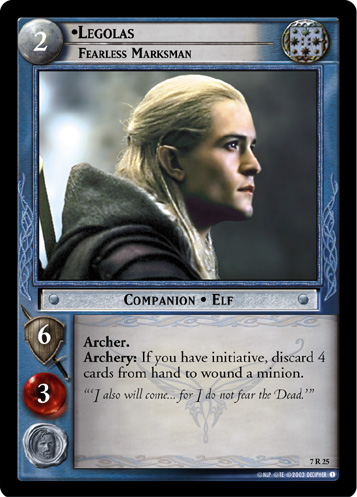 , but they're generally less effective than Greenleaf unless they're a part of a combo not described here.
, but they're generally less effective than Greenleaf unless they're a part of a combo not described here.
While it isn't strictly a wounding card, Glimpse of Fate (10U12)
 only requires that you have two elves in play to play it, so Greenleaf and an elf ally are sufficient. And if Greenleaf dies afterward, it still keeps working just fine. Rainbow decks in Movie Block are often running multiples of these conditions, oftentimes with a discard outlet (like Don’t Look at Them (6R39)
only requires that you have two elves in play to play it, so Greenleaf and an elf ally are sufficient. And if Greenleaf dies afterward, it still keeps working just fine. Rainbow decks in Movie Block are often running multiples of these conditions, oftentimes with a discard outlet (like Don’t Look at Them (6R39)
 ) to activate them. If you need a discard outlet, to activate these initiative conditions or simply to cycle your hand, Elven Sword (4C64)
) to activate them. If you need a discard outlet, to activate these initiative conditions or simply to cycle your hand, Elven Sword (4C64)
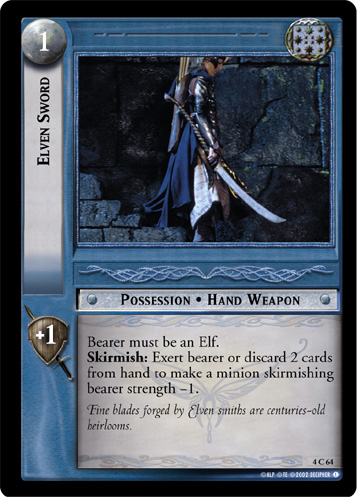 is an option, although Legolas is a poor skirmisher.
is an option, although Legolas is a poor skirmisher.
Rainbow Wounding often runs a tank companion or two to help manage enemies that can't be wounded or are simply immune to direct wounding. Arwen, Queen of Elves and Men (10R6)
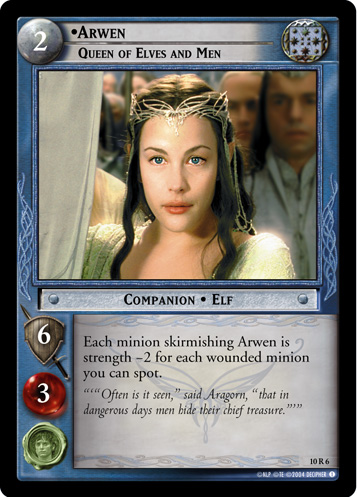 is one option for that role, especially with her strong possessions like Gwemegil (1R47)
is one option for that role, especially with her strong possessions like Gwemegil (1R47)
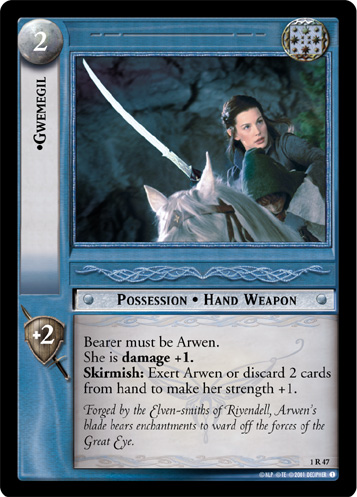 and Asfaloth (1U31)
and Asfaloth (1U31)
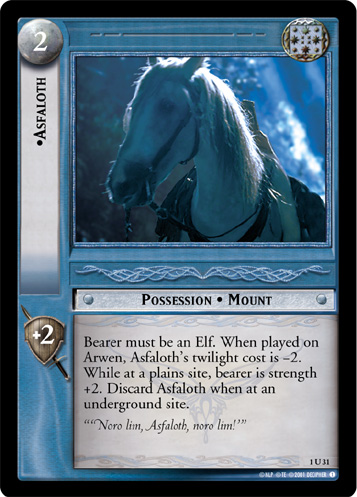 /Asfaloth, Elven Steed (7R17)
/Asfaloth, Elven Steed (7R17)
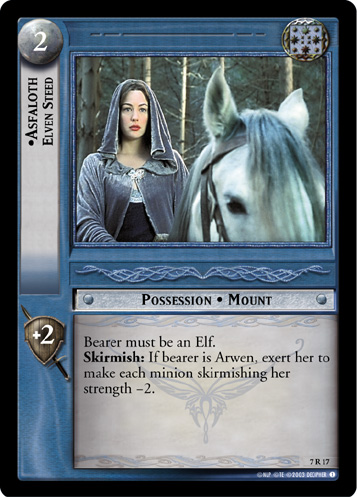 , but she also appreciates cross-culture possessions like Brego (4U263)
, but she also appreciates cross-culture possessions like Brego (4U263)
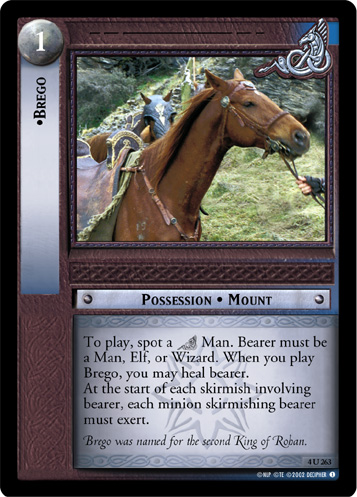 and Horse of Rohan (4C283)
and Horse of Rohan (4C283)
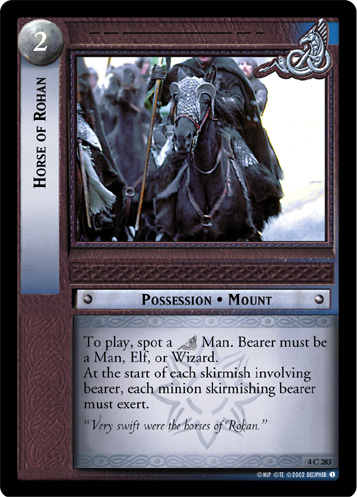 . (Lórien Swordsman (4C78)
. (Lórien Swordsman (4C78)
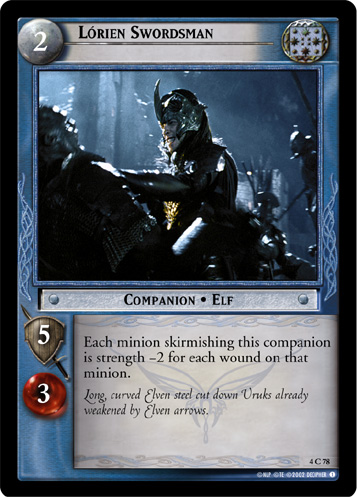 is a somewhat weaker, non-unique alternative to Arwen.) Another choice is Glorfindel, Revealed in Wrath (9R+16)
is a somewhat weaker, non-unique alternative to Arwen.) Another choice is Glorfindel, Revealed in Wrath (9R+16)
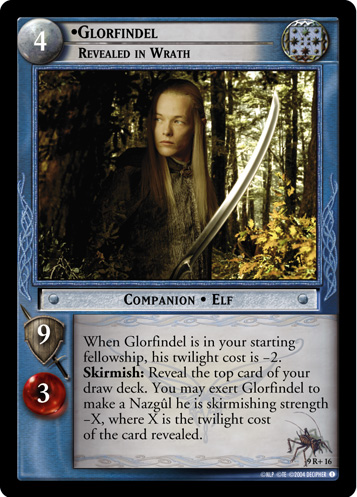 , who is cheap, efficient, and also needs no support. Alternately, if you're running a largish elven contingent, The Last Alliance of Elves and Men (1R49)
, who is cheap, efficient, and also needs no support. Alternately, if you're running a largish elven contingent, The Last Alliance of Elves and Men (1R49)
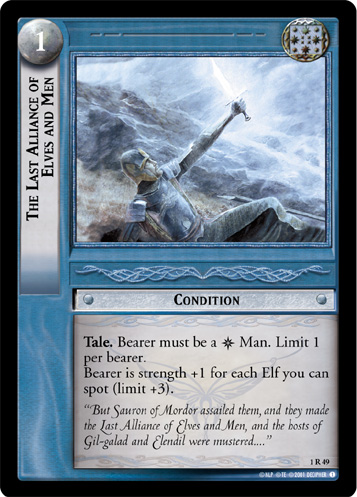 on a
on a Gondor companion is an option. (At some point, though, that deck goes from being Rainbow Wounding to an Elfman deck.)
Lady of Ithilien and Rohan support[edit]

If Greenleaf snipes minions, Éowyn, Lady of Ithilien (10R72)
 is carelessly flinging around grenades. While she's technically dealing undirected wounds (and your opponent will often try to kill off other, unimportant minions rather than the one she's skirmishing!), she does so much damage that she can finish off multiple badly-wounded minions at a time. She's one of the main cards that pushes Rainbow Wounding over the line, since on a good day she can nearly double or more the damage you've already done this turn. She can even set up wounds herself to some degree with supporting cards like Brego (4U263)
is carelessly flinging around grenades. While she's technically dealing undirected wounds (and your opponent will often try to kill off other, unimportant minions rather than the one she's skirmishing!), she does so much damage that she can finish off multiple badly-wounded minions at a time. She's one of the main cards that pushes Rainbow Wounding over the line, since on a good day she can nearly double or more the damage you've already done this turn. She can even set up wounds herself to some degree with supporting cards like Brego (4U263)
 (which might as well be her matching mount), Éowyn's Sword, Dernhelm's Blade (7R230)
(which might as well be her matching mount), Éowyn's Sword, Dernhelm's Blade (7R230)
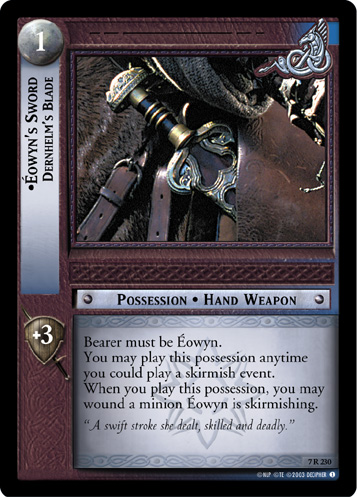 , and Rohirrim Javelin (7C248)
, and Rohirrim Javelin (7C248)
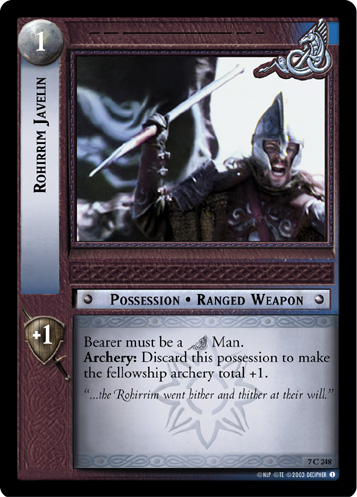 .
.
She does need some healing, and there are some strong Rohan options to do so, like Léowyn (7R239)
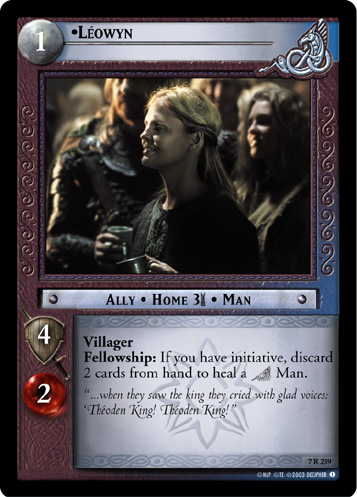 and Rohirrim Shield (5C91)
and Rohirrim Shield (5C91)
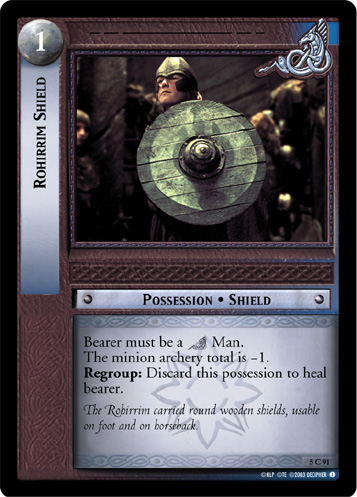 . She can also use Rohirrim Helm (5R89)
. She can also use Rohirrim Helm (5R89)
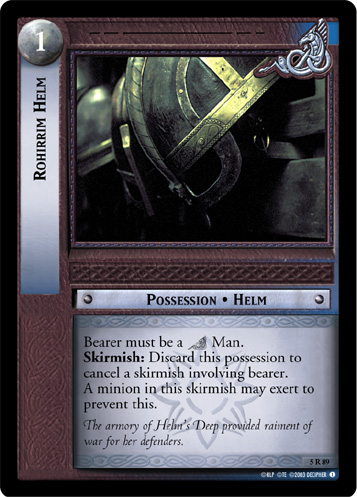 to force your opponent to make an unpleasant choice: either she exerts a minion (which will doubtless immediately be doubled by her ability), or she escapes an unwanted skirmish. If the minion is exhausted already, she just gets off scot-free. Merry, Swordthain (7R321)
to force your opponent to make an unpleasant choice: either she exerts a minion (which will doubtless immediately be doubled by her ability), or she escapes an unwanted skirmish. If the minion is exhausted already, she just gets off scot-free. Merry, Swordthain (7R321)
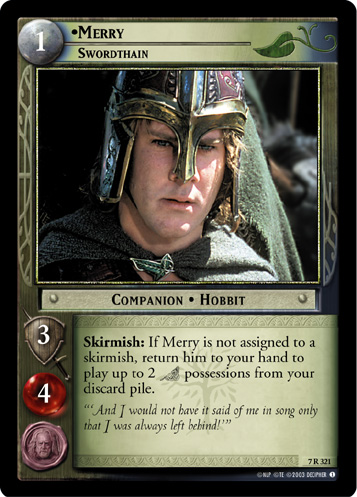 is technically a
is technically a Shire card (and is discussed more below), but can repeatedly retrieve all of these disposable possessions for reuse. If you're stacking possessions on her, you'll need some protection against Gríma, Wormtongue (4R154)
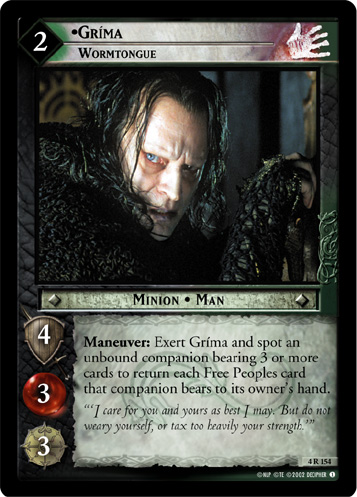 , but
, but Shire or
Dwarven cards (also discussed below) can do that.
Rohan doesn't have much for wounding tools beyond Lady of Ithilien, though. Rohirrim Javelin (7C248)
 (retrieved by Merry) and possibly Aldor, Soldier of Edoras (4R262)
(retrieved by Merry) and possibly Aldor, Soldier of Edoras (4R262)
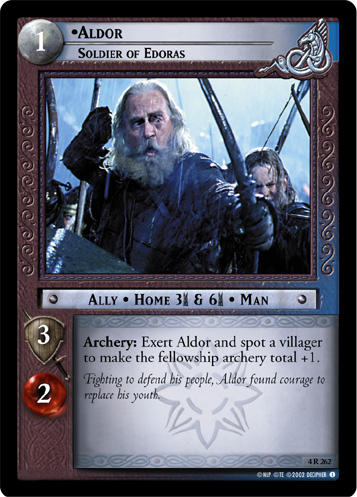 can add a few points of archery. Rainbow Wounding doesn't usually run Merry's Sword (7R242)
can add a few points of archery. Rainbow Wounding doesn't usually run Merry's Sword (7R242)
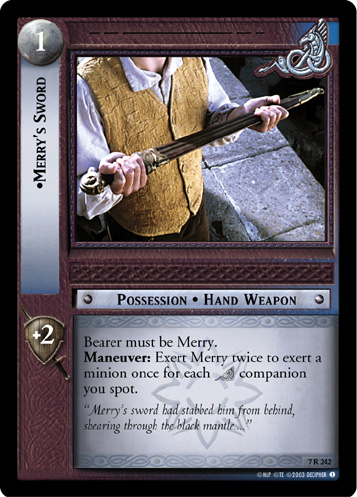 despite its strength, due to a lack of appropriate companions to spot. They do, however, have Éomer, Third Marshal of Riddermark (4R267)
despite its strength, due to a lack of appropriate companions to spot. They do, however, have Éomer, Third Marshal of Riddermark (4R267)
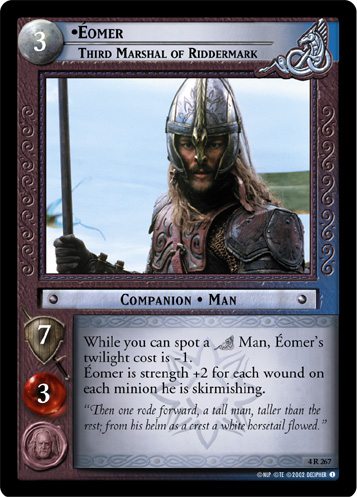 , a strong tank who benefits from having wounded minions to skirmish. And, while the
, a strong tank who benefits from having wounded minions to skirmish. And, while the Rohan initiative card, Fell Deeds Awake (10U73)
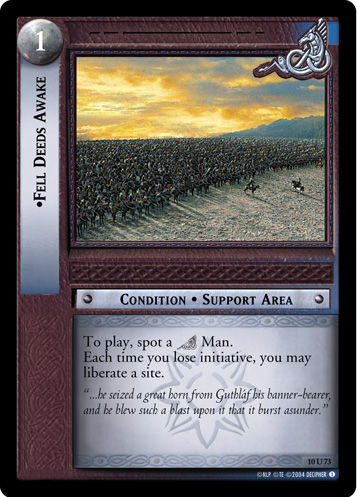 , is fairly weak, they have strong tools to manipulate initiative, like Léowyn (7R239)
, is fairly weak, they have strong tools to manipulate initiative, like Léowyn (7R239)
 and Déor (7C222)
and Déor (7C222)
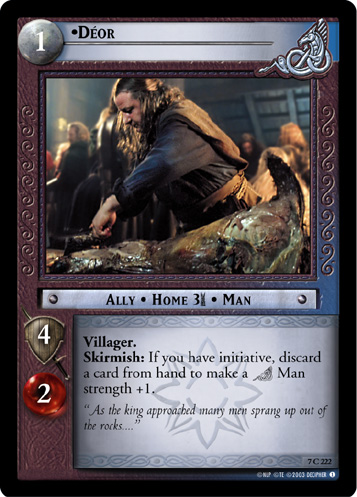 .
.
Good Sméagol Always Helps[edit]

Sméagol, Always Helps (7R71)
 is a strong addition to any Rainbow Wounding deck. Not only because he wounds minions, first exhausting them with his game text then killing them with a direct-wounding card, but also because of the costs involved in doing so. Rather than exerting himself (and requiring healing), he generates threats and consumes cards in hand. He can also deal with often-troublesome high-vitality minions, especially Enduring ones, like Shelob, Her Ladyship (10R23)
is a strong addition to any Rainbow Wounding deck. Not only because he wounds minions, first exhausting them with his game text then killing them with a direct-wounding card, but also because of the costs involved in doing so. Rather than exerting himself (and requiring healing), he generates threats and consumes cards in hand. He can also deal with often-troublesome high-vitality minions, especially Enduring ones, like Shelob, Her Ladyship (10R23)
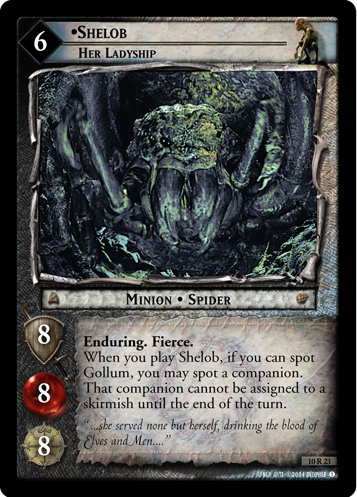 (assuming he doesn't get excluded from skirmishes by her!) and Sauron, The Lord of the Rings (9R+48)
(assuming he doesn't get excluded from skirmishes by her!) and Sauron, The Lord of the Rings (9R+48)
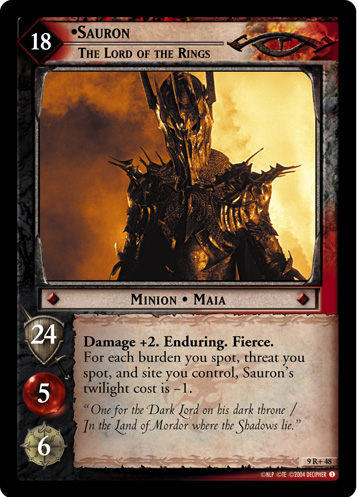 .
.
His game text only exhausts minions, and, with his low strength, he may still be in danger. The challenge is finding that last wound. The usual tool is Don’t Look at Them (6R39)
 , which is powerful (often enough to kill minions on its own!), cycles unneeded cards out of your hand, and can trigger initiative cards (especially Hardy Garrison (10U33)
, which is powerful (often enough to kill minions on its own!), cycles unneeded cards out of your hand, and can trigger initiative cards (especially Hardy Garrison (10U33)
 !). Unfortunately, it can usually only be used once or twice a turn. You can also finish off minions with Where Shall We Go (7U78)
!). Unfortunately, it can usually only be used once or twice a turn. You can also finish off minions with Where Shall We Go (7U78)
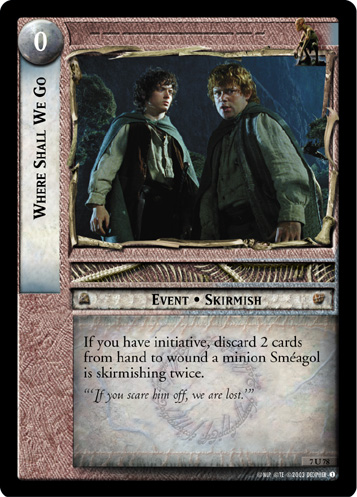 , or because he has a Frodo signet, No Use That Way (5R113)
, or because he has a Frodo signet, No Use That Way (5R113)
 . A
. A Shire contingent in your deck means you can also finish off a minion he's exhausted with Mind Your Own Affairs (4U312)
 or Unheeded (8R115)
or Unheeded (8R115)
 . Since the exhausting happens when Sméagol is assigned and not when he actually resolves his skirmish, Éowyn, Lady of Ithilien (10R72)
. Since the exhausting happens when Sméagol is assigned and not when he actually resolves his skirmish, Éowyn, Lady of Ithilien (10R72)
 or Bow of the Galadhrim (1R33)
or Bow of the Galadhrim (1R33)
 can snipe the minion before it becomes time for him to skirmish.
can snipe the minion before it becomes time for him to skirmish.
If Sméagol wins his skirmish, he has powerful tools that trigger from that. Don’t Follow the Lights (6C38)
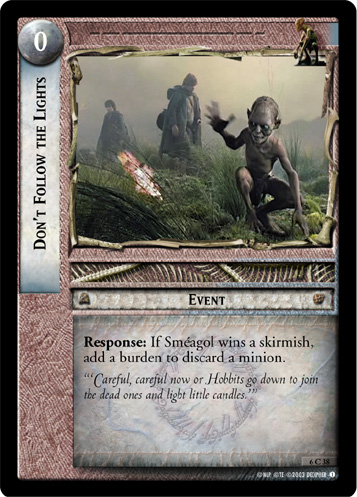 can pick off another minion with no need for wounding. Not Listening (6C43)
can pick off another minion with no need for wounding. Not Listening (6C43)
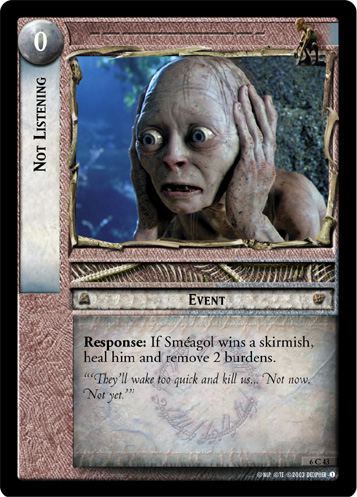 can heal him and remove the burdens placed by the
can heal him and remove the burdens placed by the Shire direct wounding cards (which, in turn, can activate The Shire Countryside (3R113)
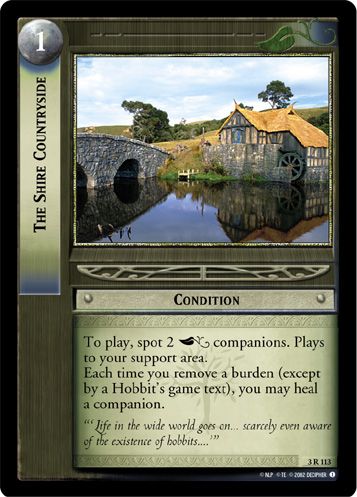 for more healing, in a
for more healing, in a Shire deck.)
While Sméagol relies on a card combo to do any work, he's not much of a downside the rest of the time. He's just generating one twilight per move, and only costs one burden to play. The worst thing that happens is that he might get killed, but that's one minion that wasn't contributing to an overwhelm on some other companion. He's best with hobbits, who often already have tools that can help protect him like Merry, Friend to Sam (1R302)
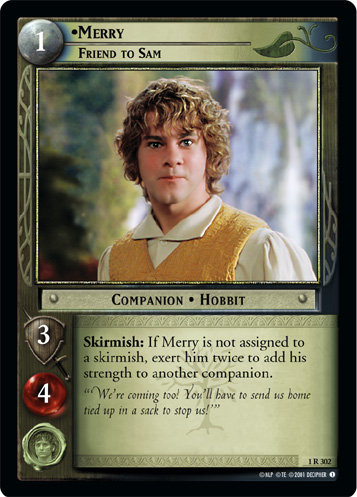 on top of the synergistic wounding tools, but he can work well with any culture on his own.
on top of the synergistic wounding tools, but he can work well with any culture on his own.
Hobbits[edit]

The hobbits of the Shire have a variety of direct wounding tools, as well as two different strong healing engines, one of which also tidily cleans up any excess burdens in the process. All of this power comes at the cost of needing to protect the vulnerable, low-strength hobbits, but that's what all the wounding and healing is for, right?
Firstly, there are the "bouncing" hobbits that can send themselves back to your hand: Pippin, Wearer of Black and Silver (7R324)
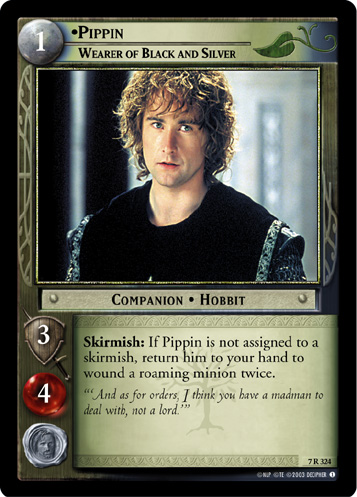 and Merry, Swordthain (7R321)
and Merry, Swordthain (7R321)
 . WOBAS can help fend off a dangerous minion at early sites (as long as it isn't a Nazgul), and Merry can help re-arm Éowyn, Lady of Ithilien (10R72)
. WOBAS can help fend off a dangerous minion at early sites (as long as it isn't a Nazgul), and Merry can help re-arm Éowyn, Lady of Ithilien (10R72)
 if her possessions are discarded. But, more importantly, when they return to your hand, all of their wounds are wiped clean. You can just use their skirmish ability whenever you like, as long as that hobbit isn't currently assigned to a skirmish: WOBAS doesn't mind if there's no roaming minion to wound, and Swordthain's "up to two" can just be zero. You can use the hobbits to soak undirected wounds like archery, but that vitality can also be put to more proactive use.
if her possessions are discarded. But, more importantly, when they return to your hand, all of their wounds are wiped clean. You can just use their skirmish ability whenever you like, as long as that hobbit isn't currently assigned to a skirmish: WOBAS doesn't mind if there's no roaming minion to wound, and Swordthain's "up to two" can just be zero. You can use the hobbits to soak undirected wounds like archery, but that vitality can also be put to more proactive use.
Shadowplay (10U114)
 can exert your hobbits to exert enemy minions when they come into play, often preventing those from using even Shadow Phase exertion abilities. Since this is happening so early in the turn, it can enable almost any other Free Peoples direct wounding card in the game, especially Legolas, Greenleaf (1R50)
can exert your hobbits to exert enemy minions when they come into play, often preventing those from using even Shadow Phase exertion abilities. Since this is happening so early in the turn, it can enable almost any other Free Peoples direct wounding card in the game, especially Legolas, Greenleaf (1R50)
 and Lady of Ithilien above. On top of this, Unheeded (8R115)
and Lady of Ithilien above. On top of this, Unheeded (8R115)
 can cut in and kill minions at any time as long as they're exerting, be it from your cards or Shadow cards. These abilities aren't just strong ways to keep from having to skirmish minions: they can also protect your deck from targeted hate cards like Gríma, Chief Counselor (5R51)
can cut in and kill minions at any time as long as they're exerting, be it from your cards or Shadow cards. These abilities aren't just strong ways to keep from having to skirmish minions: they can also protect your deck from targeted hate cards like Gríma, Chief Counselor (5R51)
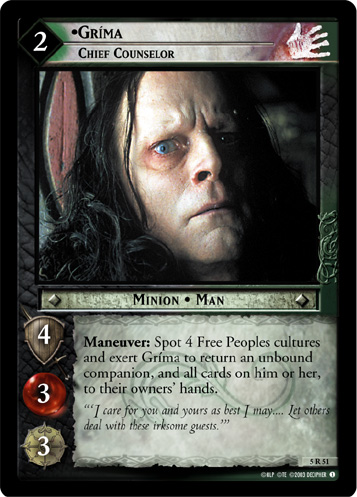 , Gríma, Wormtongue (4R154)
, Gríma, Wormtongue (4R154)
 , or Úlairë Enquëa, Lieutenant of Morgul (1U231)
, or Úlairë Enquëa, Lieutenant of Morgul (1U231)
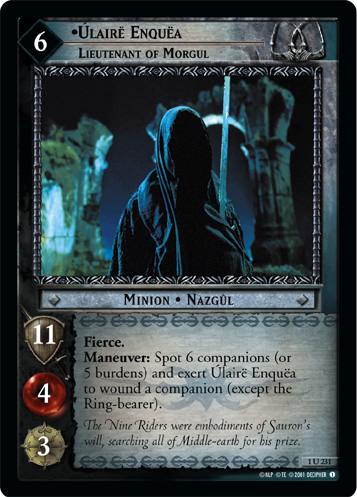 . Shadowplay/Unheeded with bouncing hobbits can be a self-sustaining source of wounds all game in a deck primarily focused on another culture, and if the hobbits end up being less useful, they can simply be discarded or thrown under the bus.
. Shadowplay/Unheeded with bouncing hobbits can be a self-sustaining source of wounds all game in a deck primarily focused on another culture, and if the hobbits end up being less useful, they can simply be discarded or thrown under the bus.
Shire
 culture also has strong skirmish wounding, generally based on placing burdens to wound minions who are skirmishing Frodo or Frodo-signet characters. Some of these don't even require any hobbits, despite being
culture also has strong skirmish wounding, generally based on placing burdens to wound minions who are skirmishing Frodo or Frodo-signet characters. Some of these don't even require any hobbits, despite being Shire cards: No Use That Way (5R113)
 can wound any minion skirmishing a Frodo-signet companion (like Greenleaf or Always Helps, above!) and Power According to His Stature (1R308)
can wound any minion skirmishing a Frodo-signet companion (like Greenleaf or Always Helps, above!) and Power According to His Stature (1R308)
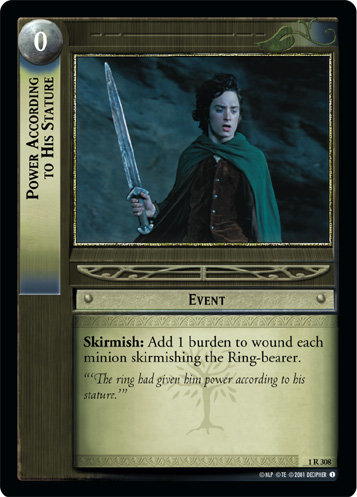 can wound minions skirmishing any ring-bearer, which is especially strong against swarm decks. Some do have a bit of cultural enforcement, though: Cliffs of Emyn Muil (4R299)
can wound minions skirmishing any ring-bearer, which is especially strong against swarm decks. Some do have a bit of cultural enforcement, though: Cliffs of Emyn Muil (4R299)
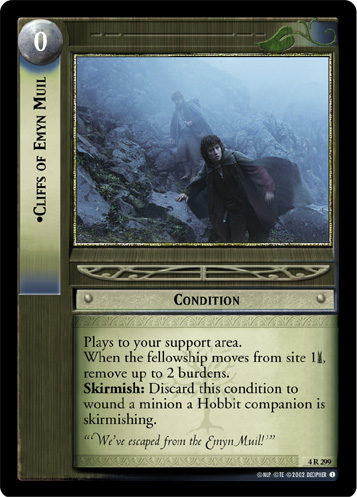 can wound any minion skirmishing any hobbit, and Mind Your Own Affairs (4U312)
can wound any minion skirmishing any hobbit, and Mind Your Own Affairs (4U312)
 spots Frodo to wound a minion skirmishing a Frodo-signet companion. All of these events can be recurred with Birthday Present (10R104)
spots Frodo to wound a minion skirmishing a Frodo-signet companion. All of these events can be recurred with Birthday Present (10R104)
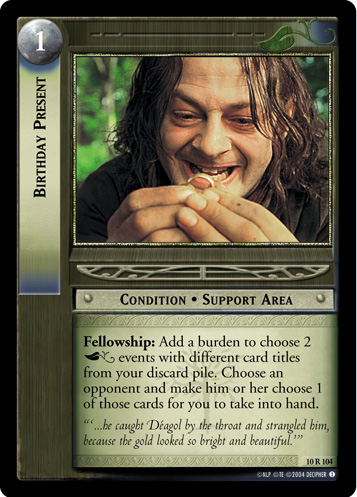 , albeit at the cost of even more burdens. Frodo, Wicked Masster! (7R318)
, albeit at the cost of even more burdens. Frodo, Wicked Masster! (7R318)
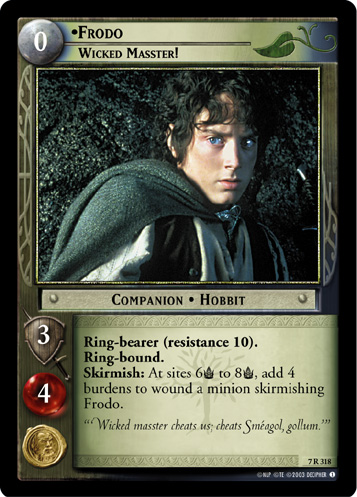 has a minion-wounding ability of his own, albeit at such a high cost that he is rarely played.
has a minion-wounding ability of his own, albeit at such a high cost that he is rarely played.
The burden costs end up being a soft form of cultural enforcement, however. Firstly, Frodo generally has the highest practical resistance of any ring-bearer in a rainbow deck, especially if you're playing Frodo, Resolute Hobbit (10P121)
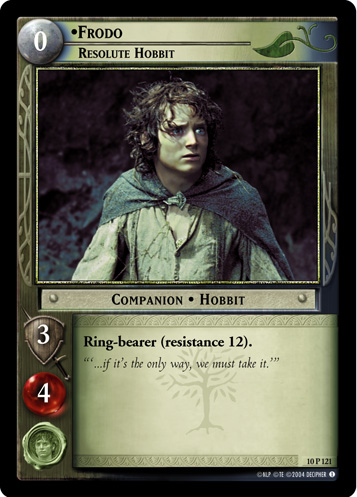 . But hobbits also have a very strong initiative condition that removes a burden almost every turn, sometimes more than once a turn: A Light in His Mind (10U108)
. But hobbits also have a very strong initiative condition that removes a burden almost every turn, sometimes more than once a turn: A Light in His Mind (10U108)
 . Sam, Resolute Halfling (7R327)
. Sam, Resolute Halfling (7R327)
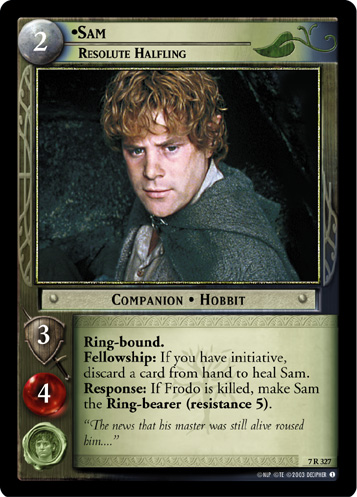 can activate it almost at will, while serving as a well of exertions for Shadowplay/Unheeded. If you "bounce" Swordthain or WOBAS back to your hand, that can bring you back up to four cards, regaining initiative so you can lose it again to get an extra use of A Light in His Mind. ALIHM usually isn't enough burden removal on its own to support Birthday Present, but it can be supplemented with Frodo's Cloak (4R303)
can activate it almost at will, while serving as a well of exertions for Shadowplay/Unheeded. If you "bounce" Swordthain or WOBAS back to your hand, that can bring you back up to four cards, regaining initiative so you can lose it again to get an extra use of A Light in His Mind. ALIHM usually isn't enough burden removal on its own to support Birthday Present, but it can be supplemented with Frodo's Cloak (4R303)
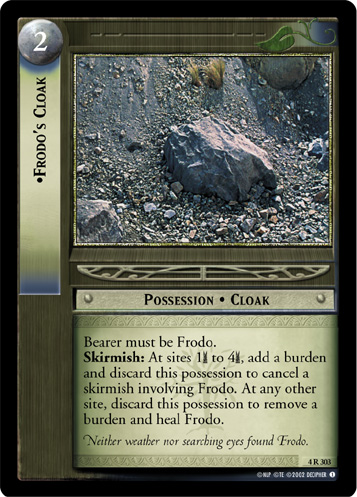 , Brace of Coneys (4C298)
, Brace of Coneys (4C298)
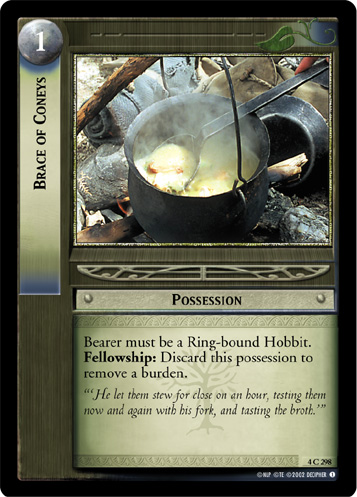 , Nine-fingered Frodo and the Ring of Doom (10C112)
, Nine-fingered Frodo and the Ring of Doom (10C112)
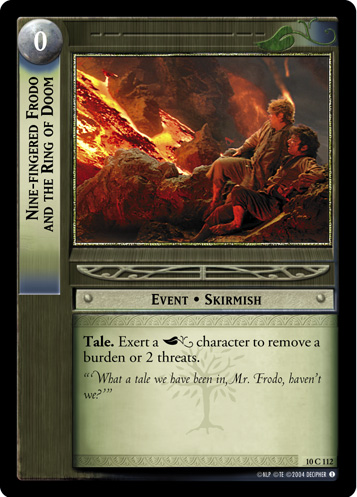 , and, if you're using Sméagol, Not Listening (6C43)
, and, if you're using Sméagol, Not Listening (6C43)
 . No Help for It (5R112)
. No Help for It (5R112)
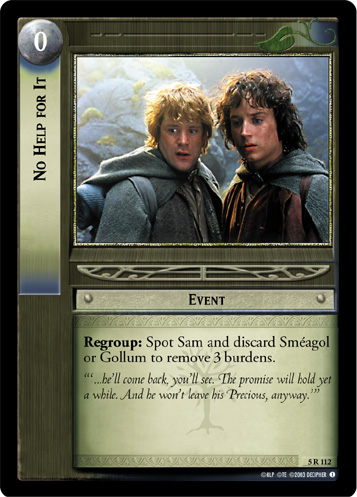 combined with Frodo, Master of the Precious (5U111)
combined with Frodo, Master of the Precious (5U111)
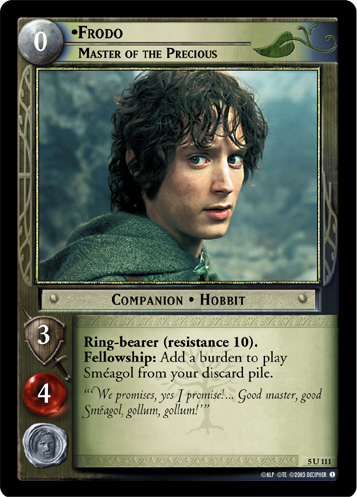 is another way to dump burdens while also healing Sméagol by "bouncing" him in and out of your discard pile.
is another way to dump burdens while also healing Sméagol by "bouncing" him in and out of your discard pile.
All of this burden removal may seem excessive, but you often want to place and remove as many burdens as possible because of another powerful Shire card: The Shire Countryside (3R113)
 . Every time you remove a burden, it heals a companion for each copy of Shire Countryside you have, which can turn into quite a lot of healing! Funnel that healing to a character with a powerful exert-to-wound ability, and you can mow down troublesome minions every turn.
. Every time you remove a burden, it heals a companion for each copy of Shire Countryside you have, which can turn into quite a lot of healing! Funnel that healing to a character with a powerful exert-to-wound ability, and you can mow down troublesome minions every turn.
Gimli and Slaked Thirsts[edit]

Gimli—almost always Gimli, Bearer of Grudges (9R+4)
 or Gimli, Feared Axeman (7R7)
or Gimli, Feared Axeman (7R7)
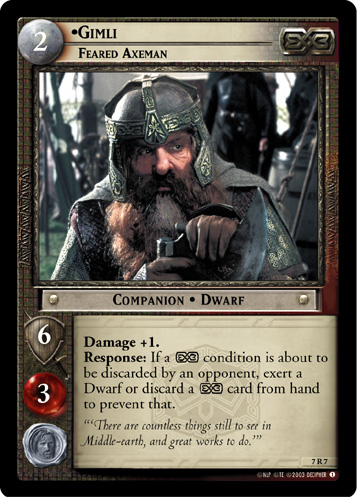 —can bring a lot to a Rainbow Wounding deck. The main benefit to having him is the Preparations (7R12)
—can bring a lot to a Rainbow Wounding deck. The main benefit to having him is the Preparations (7R12)
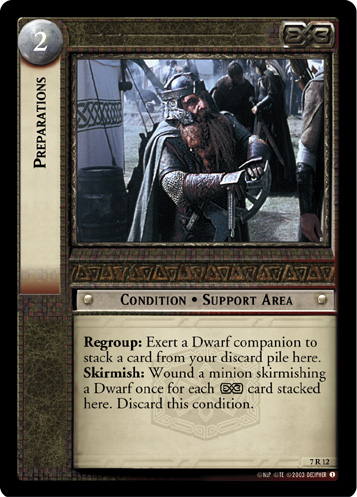 and Slaked Thirsts (7U14)
and Slaked Thirsts (7U14)
 combo. Not only is Slaked Thirsts a powerful card, placing two wounds for the cost of one exertion, but Gimli doesn't need to be healthy for the turn that you're playing Slaked Thirsts. You can make sure any excess healing (for example, from a sanctuary) won't go to waste by using it to place Slaked Thirsts on Preparations. With Bearer of Grudges and The One Ring, Answer To All Riddles (4R1)
combo. Not only is Slaked Thirsts a powerful card, placing two wounds for the cost of one exertion, but Gimli doesn't need to be healthy for the turn that you're playing Slaked Thirsts. You can make sure any excess healing (for example, from a sanctuary) won't go to waste by using it to place Slaked Thirsts on Preparations. With Bearer of Grudges and The One Ring, Answer To All Riddles (4R1)
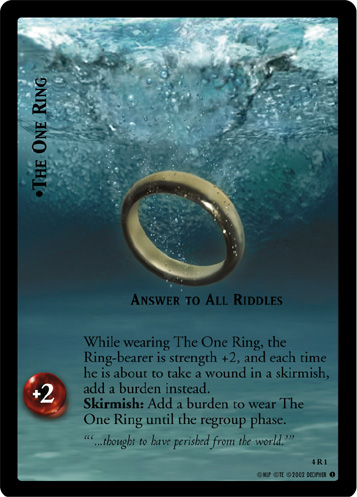 , you have plenty of wounds you can absorb, and most Shadow sides won't unexpectedly wound the ring-bearer. Any extra copies of Preparations won't go to waste either, since they can be used as a (weak) direct-wounding card. If you draw Slaked Thirsts, you can play it when you have exactly three other cards in hand to quickly lose then regain initiative for the other cultures' initiative conditions. Like Shadowplay (10U114)
, you have plenty of wounds you can absorb, and most Shadow sides won't unexpectedly wound the ring-bearer. Any extra copies of Preparations won't go to waste either, since they can be used as a (weak) direct-wounding card. If you draw Slaked Thirsts, you can play it when you have exactly three other cards in hand to quickly lose then regain initiative for the other cultures' initiative conditions. Like Shadowplay (10U114)
 above, Slaked Thirsts is a powerful tool for stymieing obnoxious hate cards like Gríma, Chief Counselor (5R51)
above, Slaked Thirsts is a powerful tool for stymieing obnoxious hate cards like Gríma, Chief Counselor (5R51)
 , Gríma, Wormtongue (4R154)
, Gríma, Wormtongue (4R154)
 , or Úlairë Enquëa, Lieutenant of Morgul (1U231)
, or Úlairë Enquëa, Lieutenant of Morgul (1U231)
 . Compared to Slaked Thirsts, the
. Compared to Slaked Thirsts, the Dwarven wounding cards are fairly anemic. Quick As May Be (4U53)
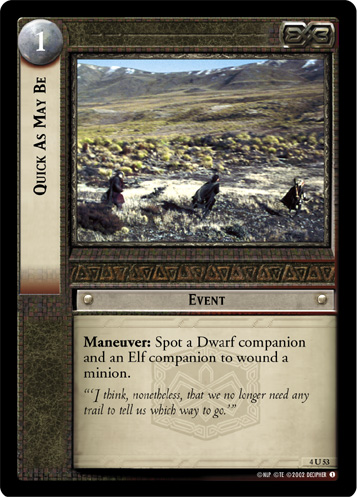 is cheap and basically free, so it's worth finding space for sometimes. Baruk Khazâd (5R5)
is cheap and basically free, so it's worth finding space for sometimes. Baruk Khazâd (5R5)
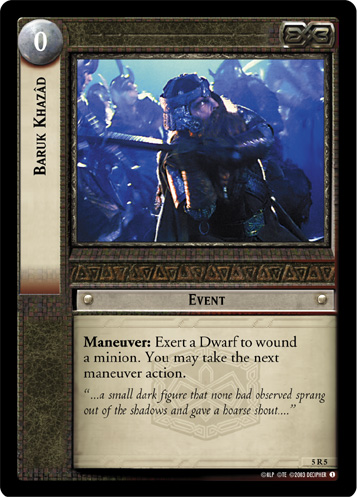 can be useful, but it isn't as strong as Slaked Thirsts and can't easily be replayed. Here Lies Balin, Son of Fundin (1C19)
can be useful, but it isn't as strong as Slaked Thirsts and can't easily be replayed. Here Lies Balin, Son of Fundin (1C19)
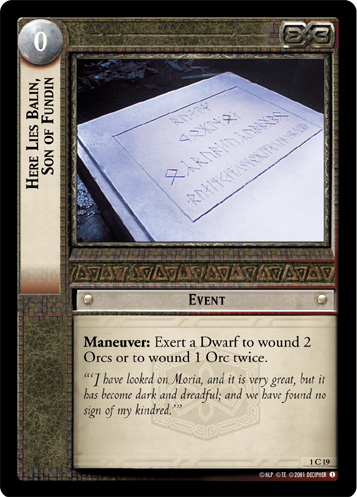 is very strong when it works, especially against
is very strong when it works, especially against Moria, but is a dead card against decks that don't use orcs and won't help against many large, dangerous minions.
The next most-important reason to bring Gimli is Shoulder to Shoulder (1C59)
 . If you're bringing Legolas, Greenleaf (1R50)
. If you're bringing Legolas, Greenleaf (1R50)
 , the two of them can share their vitality pool for Greenleaf's exertion ability or Preparations. As with the
, the two of them can share their vitality pool for Greenleaf's exertion ability or Preparations. As with the Elven contingent above, adding in Elrond, Herald to Gil-galad (3R13)
 gives them a powerful source of healing every single turn, at the cost of generating some twilight in the Maneuver Phase.
gives them a powerful source of healing every single turn, at the cost of generating some twilight in the Maneuver Phase.
Having a single dwarf in your deck also opens up a lot of other cards, especially if your deck already has lots of healing or tends to generate some threats. Ever My Heart Rises (4R46)
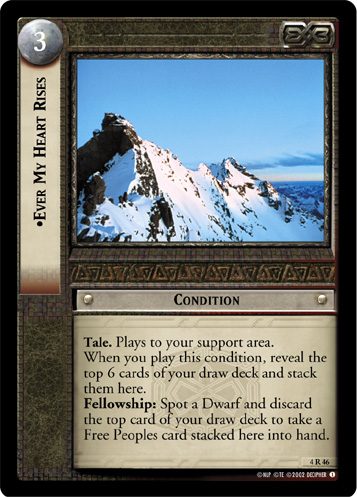 (generally downloaded with Dunharrow Plateau (7U329)
(generally downloaded with Dunharrow Plateau (7U329)
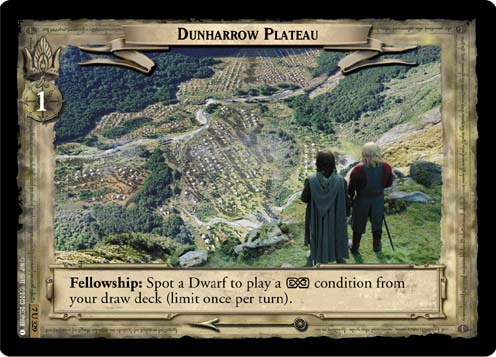 ) can help your deck set up more consistently to start, as long as you can don't mind milling yourself a little bit. Gimli's Battle Axe, Trusted Weapon (7R9)
) can help your deck set up more consistently to start, as long as you can don't mind milling yourself a little bit. Gimli's Battle Axe, Trusted Weapon (7R9)
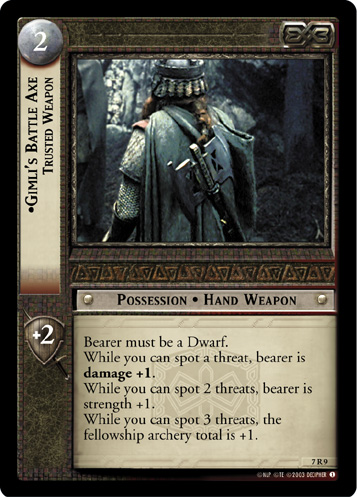 contributes an extra archery wound once some threats are stacked, although some decks instead use Axe of Erebor (4R41)
contributes an extra archery wound once some threats are stacked, although some decks instead use Axe of Erebor (4R41)
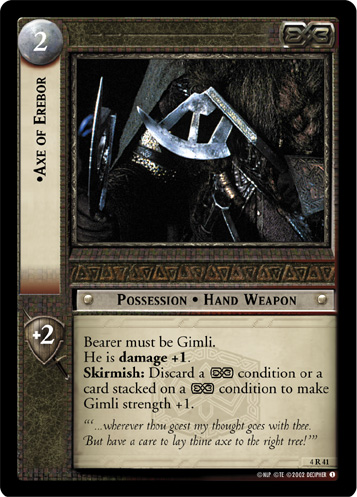 since it can get a strength bonus freeing up any Shadow cards stuck on EMHR, and some decks don't bother at all because of the possession hate in the format. Blood Runs Chill (8R3)
since it can get a strength bonus freeing up any Shadow cards stuck on EMHR, and some decks don't bother at all because of the possession hate in the format. Blood Runs Chill (8R3)
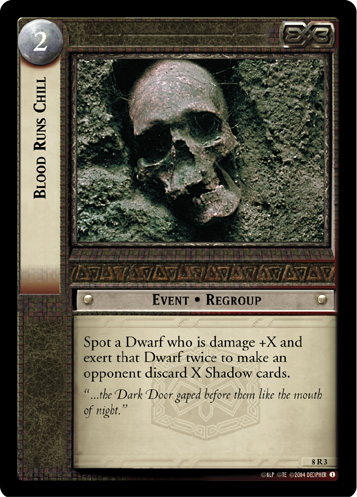 can discard some minions who survived the skirmish phase or clean out your opponent's support area. Ring of Fury (9R+7)
can discard some minions who survived the skirmish phase or clean out your opponent's support area. Ring of Fury (9R+7)
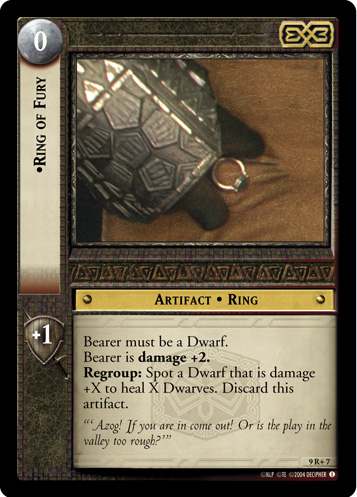 is a good choice to help protect Gimli, and it also boosts Blood Runs Chill and can be downloaded with The One Ring, The Binding Ring (9R+1)
is a good choice to help protect Gimli, and it also boosts Blood Runs Chill and can be downloaded with The One Ring, The Binding Ring (9R+1)
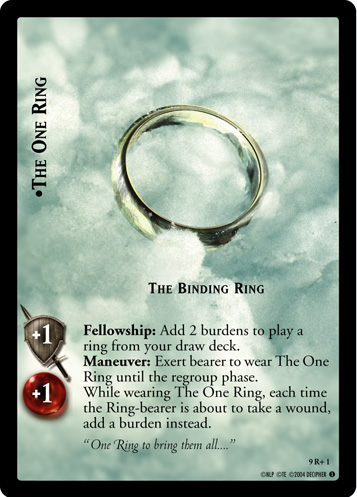 . Any of the
. Any of the Dwarven rings are fine, too.
Aragorn, Faramir, and Gondorian tools[edit]
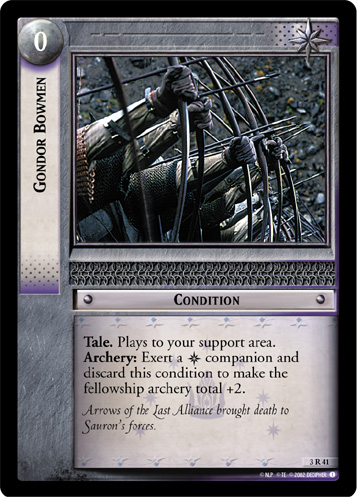
A Gondor contingent in Rainbow Wounding is often very small. Aragorn, Elessar Telcontar (10R25)
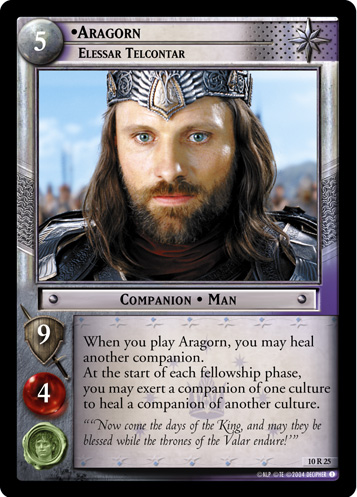 is a powerful skirmisher, and he can use Andúril, Flame of the West (7R79)
is a powerful skirmisher, and he can use Andúril, Flame of the West (7R79)
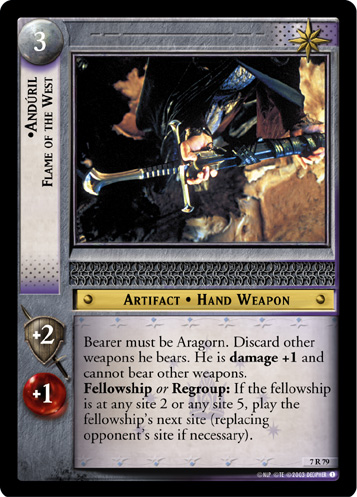 , The Last Alliance of Elves and Men (1R49)
, The Last Alliance of Elves and Men (1R49)
 , and/or Aragorn’s Bow (1R90)
, and/or Aragorn’s Bow (1R90)
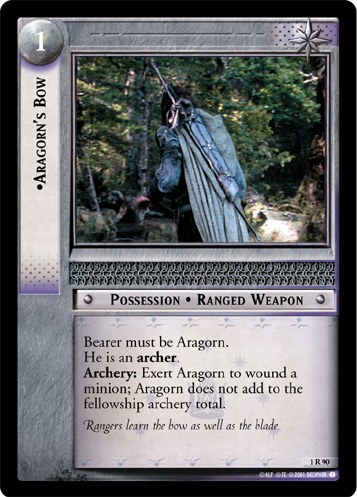 (although the last is less common, due to pervasive possession hate). He also offers some initial healing when played, then helps sort wounds into the right places: off of characters who want to exert, and onto himself or bouncing hobbits. (Occasionally you see Aragorn, King in Exile (1P365)
(although the last is less common, due to pervasive possession hate). He also offers some initial healing when played, then helps sort wounds into the right places: off of characters who want to exert, and onto himself or bouncing hobbits. (Occasionally you see Aragorn, King in Exile (1P365)
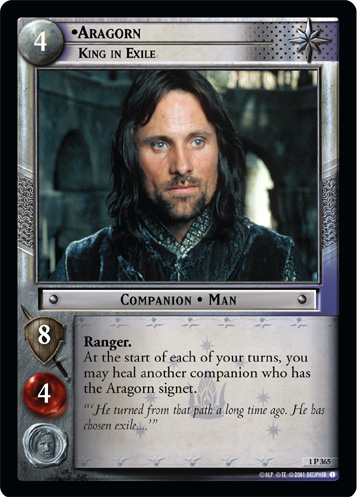 instead, although that's less common as there are relatively few Aragorn-signet companions well-suited to this deck.) Faramir, Son of Denethor (4C117)
instead, although that's less common as there are relatively few Aragorn-signet companions well-suited to this deck.) Faramir, Son of Denethor (4C117)
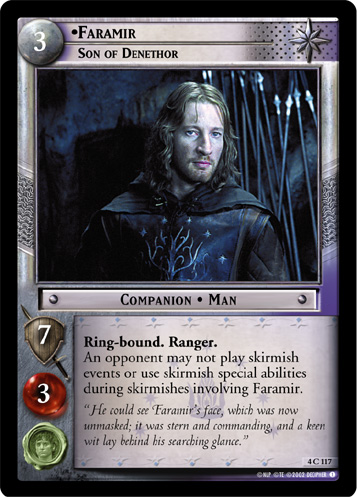 is also reasonably popular, since he shuts down some obnoxious strategies and can use Faramir's Bow (4R118)
is also reasonably popular, since he shuts down some obnoxious strategies and can use Faramir's Bow (4R118)
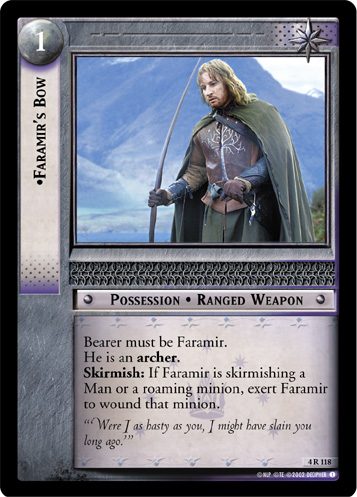 . Occasionally some Rainbow Wounding decks may use Isildur, Bearer of Heirlooms (9R+33)
. Occasionally some Rainbow Wounding decks may use Isildur, Bearer of Heirlooms (9R+33)
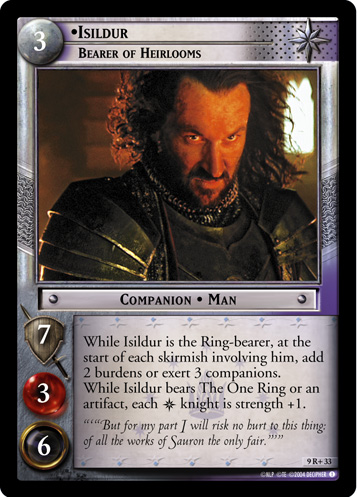 , but his low resistance makes him a bit of a liability.
, but his low resistance makes him a bit of a liability.
The reason you're using these men is mainly to splash in some of the Gondor wounding and healing tools, which are considerable. Hardy Garrison (10U33)
 is both a direct wounding tool and one of the strongest initiative cards. Gondor Bowmen (3R41)
is both a direct wounding tool and one of the strongest initiative cards. Gondor Bowmen (3R41)
 is two wounds for one exertion, and, while those wounds aren't aimed, you can play the card before you need it to get it out of your hand. Citadel of the Stars (5C32)
is two wounds for one exertion, and, while those wounds aren't aimed, you can play the card before you need it to get it out of your hand. Citadel of the Stars (5C32)
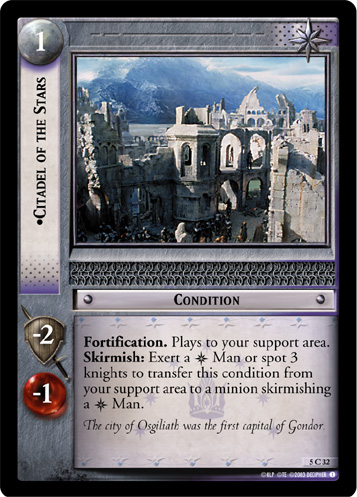 is even better than a wounding card, since it doesn't count as a wound (for the purposes of effects like Enduring) and can often set up a minion to lose a skirmish and thus another wound. (Most other fortifications see little play outside of Gondor Knights.) Defend It and Hope (4C115)
is even better than a wounding card, since it doesn't count as a wound (for the purposes of effects like Enduring) and can often set up a minion to lose a skirmish and thus another wound. (Most other fortifications see little play outside of Gondor Knights.) Defend It and Hope (4C115)
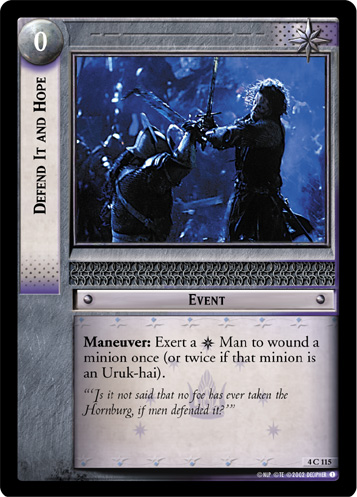 is a passable card, but rarely played due to the quality of the alternatives. Citadel of Minas Tirith (3R40)
is a passable card, but rarely played due to the quality of the alternatives. Citadel of Minas Tirith (3R40)
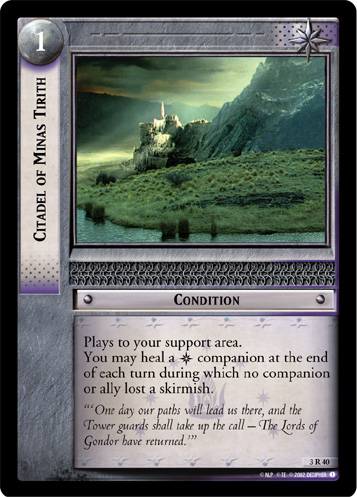 is powerful healing that works every turn, but only it only works if you're not losing any skirmishes at all, which can be unreliable. Athelas (1U94)
is powerful healing that works every turn, but only it only works if you're not losing any skirmishes at all, which can be unreliable. Athelas (1U94)
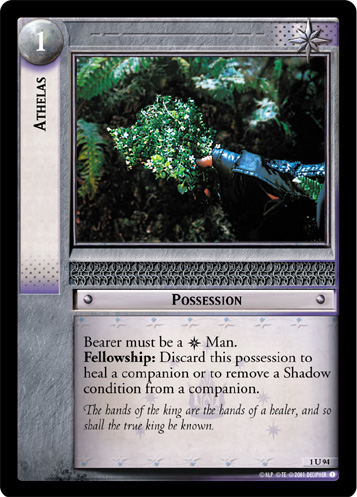 is cheap easy on-demand healing, but it's hard to find space for such a low-impact card.
is cheap easy on-demand healing, but it's hard to find space for such a low-impact card.
Gandalf[edit]
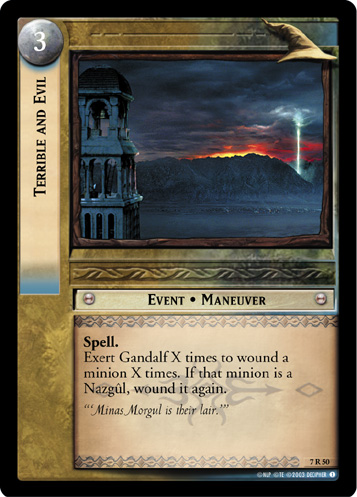
Pretty much every deck could make space for Gandalf and his supporting cards, and Rainbow Wounding is no exception. Rainbow decks often run into the problem that their cultures' tools are locked behind cultural enforcement, and Gandalf is a walking toolbox. Need to deal with Corsair boats, Hides (4R19)
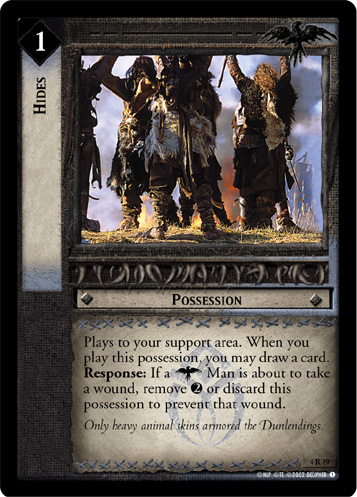 , Grond, Hammer of the Underworld (8R103)
, Grond, Hammer of the Underworld (8R103)
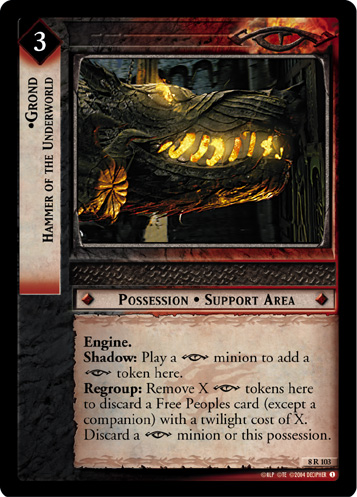 , and some of the troublesome wound-preventing weapons? Roll of Thunder (4U99)
, and some of the troublesome wound-preventing weapons? Roll of Thunder (4U99)
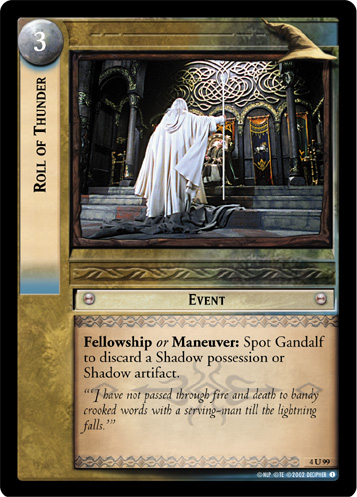 has you covered. Losing skirmishes to minions that squeak through? Gandalf is himself a competent skirmisher, can make himself moreso with Gandalf's Staff (2R22)
has you covered. Losing skirmishes to minions that squeak through? Gandalf is himself a competent skirmisher, can make himself moreso with Gandalf's Staff (2R22)
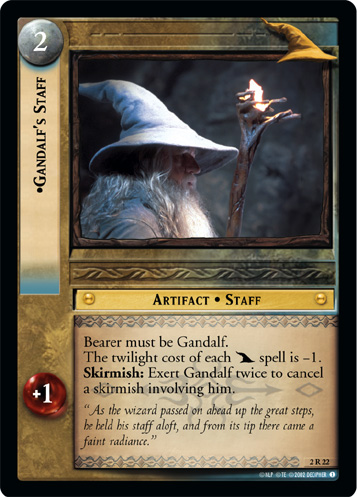 , and can help your other companions with Servant of the Secret Fire (1R83)
, and can help your other companions with Servant of the Secret Fire (1R83)
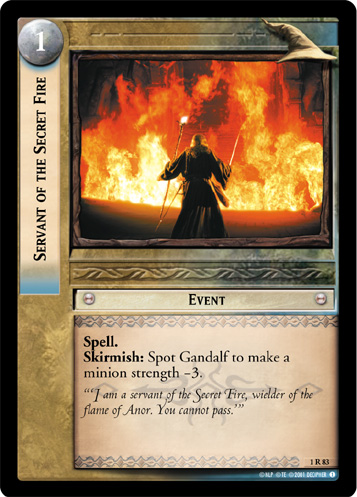 . Having trouble finding key cards for a combo? On Your Doorstep (8U19)
. Having trouble finding key cards for a combo? On Your Doorstep (8U19)
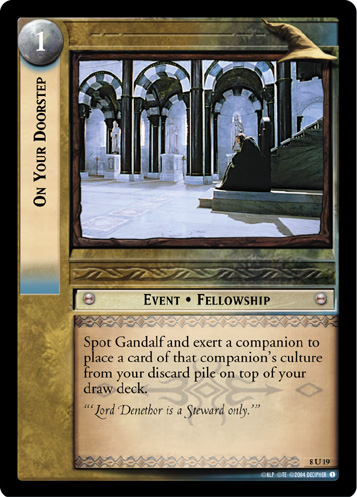 can handle that. Burdens stacking up? Narya (3R34)
can handle that. Burdens stacking up? Narya (3R34)
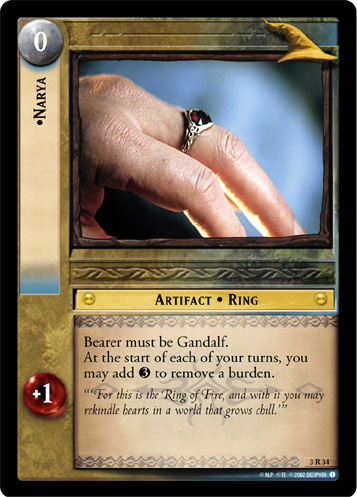 can help. Gandalf even has his own powerful direct wounding card, Terrible and Evil (7R50)
can help. Gandalf even has his own powerful direct wounding card, Terrible and Evil (7R50)
 , and a fairly decent initiative condition, Brooding on Tomorrow (10U15)
, and a fairly decent initiative condition, Brooding on Tomorrow (10U15)
 .
.
Gandalf, Leader of Men (8R15)
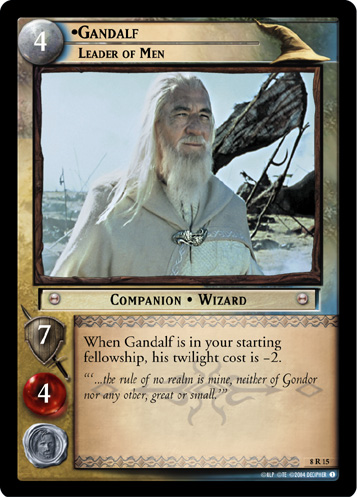 is the most popular version of Gandalf, since he's the only one that's practical in a starting Fellowship. Beyond that, it's a matter of taste. Gandalf, The White Wizard (4C90)
is the most popular version of Gandalf, since he's the only one that's practical in a starting Fellowship. Beyond that, it's a matter of taste. Gandalf, The White Wizard (4C90)
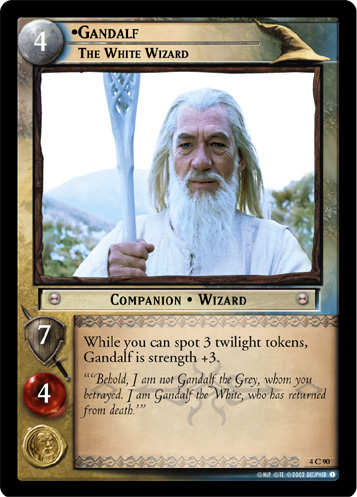 is a powerful but unreliable skirmisher. Gandalf, Friend of the Shirefolk (1R72)
is a powerful but unreliable skirmisher. Gandalf, Friend of the Shirefolk (1R72)
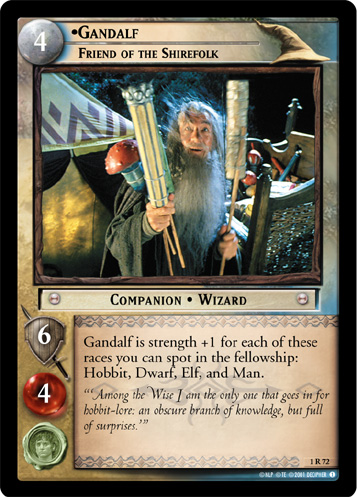 can work if you're really going deep rainbow, although you'll need protection against Gríma, Chief Counselor (5R51)
can work if you're really going deep rainbow, although you'll need protection against Gríma, Chief Counselor (5R51)
 . Gandalf, The Grey Pilgrim (2P122)
. Gandalf, The Grey Pilgrim (2P122)
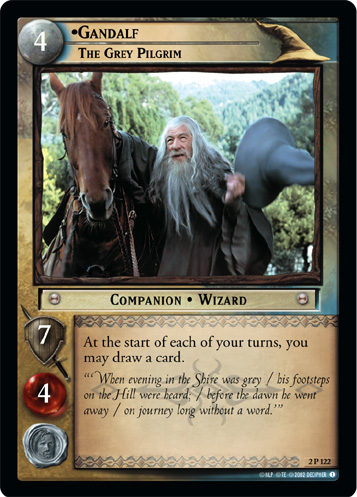 is just always helpful. Gandalf, Greyhame (4R89)
is just always helpful. Gandalf, Greyhame (4R89)
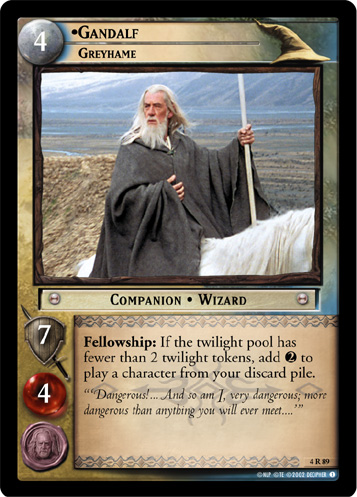 can work if your deck is really dedicated to self-milling, or as a cheaper way to replay Sméagol after using No Help for It (5R112)
can work if your deck is really dedicated to self-milling, or as a cheaper way to replay Sméagol after using No Help for It (5R112)
 .
.
Since you are very likely playing A Wizard Is Never Late (1R87)
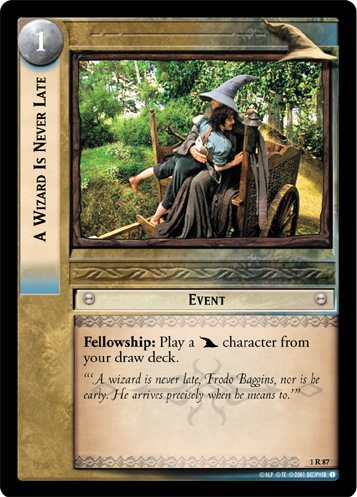 to download Gandalf, it can be worth it to include some other
to download Gandalf, it can be worth it to include some other Gandalf culture characters to make use of AWINL after Gandalf is already in play. Barliman Butterbur, Prancing Pony Proprietor (1U70)
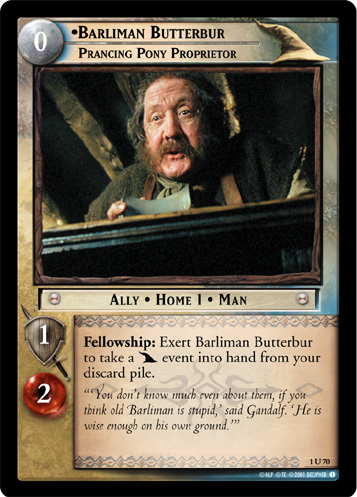 can recur all of those
can recur all of those Gandalf events you're using. Radagast, The Brown (9R+26)
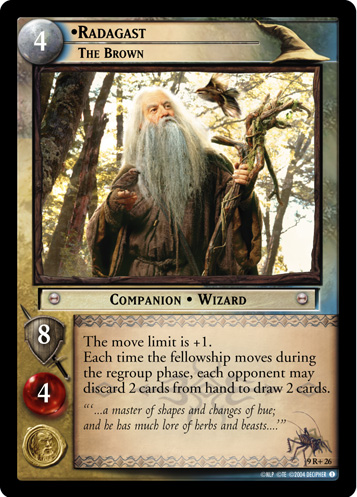 is ubiquitous as a splash companion for a reason: his move limit increase is very powerful.
is ubiquitous as a splash companion for a reason: his move limit increase is very powerful.
Assembling Your Deck[edit]
The place to start thinking about building a Rainbow Wounding deck is what you want your Fellowship to look like, both to start and under ideal circumstances. Once you know that, the rest of the deck falls into place naturally. Here are two common examples:
You can start with Gimli, Bearer of Grudges (9R+4)
 (almost always with The One Ring, Answer To All Riddles (4R1)
(almost always with The One Ring, Answer To All Riddles (4R1)
 ) to enable Preparations (7R12)
) to enable Preparations (7R12)
 /Slaked Thirsts (7U14)
/Slaked Thirsts (7U14)
 and/or Shoulder to Shoulder (1C59)
and/or Shoulder to Shoulder (1C59)
 . This version of the deck will generally have less wounding from events (other than Slaked Thirsts), and more wounding from characters like Legolas, Greenleaf (1R50)
. This version of the deck will generally have less wounding from events (other than Slaked Thirsts), and more wounding from characters like Legolas, Greenleaf (1R50)
 and Éowyn, Lady of Ithilien (10R72)
and Éowyn, Lady of Ithilien (10R72)
 . As a result, it tends to need more healing, and tends to rely more heavily on keeping those specific characters alive. How you plan to do that varies: Aragorn and
. As a result, it tends to need more healing, and tends to rely more heavily on keeping those specific characters alive. How you plan to do that varies: Aragorn and Gondor means a fourth culture, but offers archery wounds and some strong skirmishers. Elves offer healing and their own archery.
Rohan has a strong skirmisher in Éomer, Third Marshal of Riddermark (4R267)
 and better protection for Eowyn, but otherwise only weakish healing and skirmishing. You can include Sméagol, Always Helps (7R71)
and better protection for Eowyn, but otherwise only weakish healing and skirmishing. You can include Sméagol, Always Helps (7R71)
 in this deck, and the cycling from Don’t Look at Them (6R39)
in this deck, and the cycling from Don’t Look at Them (6R39)
 is nice, but you'll really need to land good combos with Lady of Ithilien to get a lot of mileage out of him when Don't Look At Them isn't in play. You can also consider the bounding hobbits for Shadowplay (10U114)
is nice, but you'll really need to land good combos with Lady of Ithilien to get a lot of mileage out of him when Don't Look At Them isn't in play. You can also consider the bounding hobbits for Shadowplay (10U114)
 and possibly Unheeded (8R115)
and possibly Unheeded (8R115)
 .
.
Example deck: Rainbow Wounding / Twilight Corruption, a Movie Block deck by Imrahil on The Last Homely House forums
Alternately, you can start with Frodo (usually Frodo, Resolute Hobbit (10P121)
 or Frodo, Son of Drogo (1C290)
or Frodo, Son of Drogo (1C290)
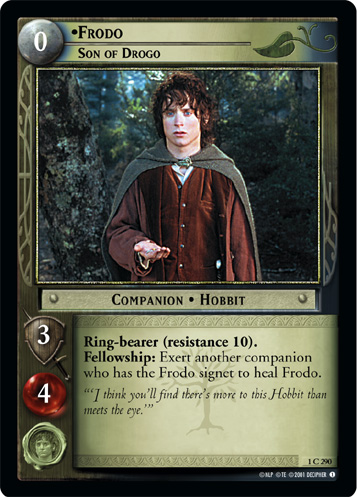 ) to allow the Frodo-signet wounding cards, as well as Shadowplay (10U114)
) to allow the Frodo-signet wounding cards, as well as Shadowplay (10U114)
 and possibly Unheeded (8R115)
and possibly Unheeded (8R115)
 . This deck is now less concerned about healing characters, and thus less invested in keeping specific companions alive, but it does need some way to get rid of the burdens, and possibly replay the events. Legolas, Greenleaf (1R50)
. This deck is now less concerned about healing characters, and thus less invested in keeping specific companions alive, but it does need some way to get rid of the burdens, and possibly replay the events. Legolas, Greenleaf (1R50)
 , Sméagol, Always Helps (7R71)
, Sméagol, Always Helps (7R71)
 , and Aragorn, Elessar Telcontar (10R25)
, and Aragorn, Elessar Telcontar (10R25)
 all have Frodo signets, so you can use the wounding events to set up or finish off minions with them. These cards all do stack up burdens pretty fast.
all have Frodo signets, so you can use the wounding events to set up or finish off minions with them. These cards all do stack up burdens pretty fast. Shire and
Gollum cultures can help with those burdens, with Nine-fingered Frodo and the Ring of Doom (10C112)
 , Not Listening (6C43)
, Not Listening (6C43)
 , and/or A Light in His Mind (10U108)
, and/or A Light in His Mind (10U108)
 . You'll want at least a second hobbit for A Light in His Mind, and that also opens up The Shire Countryside (3R113)
. You'll want at least a second hobbit for A Light in His Mind, and that also opens up The Shire Countryside (3R113)
 , to turn all that burden removal into healing.
, to turn all that burden removal into healing.
Example deck: Just a fun deck, a Movie Block deck by Smeagollum on The Last Homely House forums
Counterplay[edit]

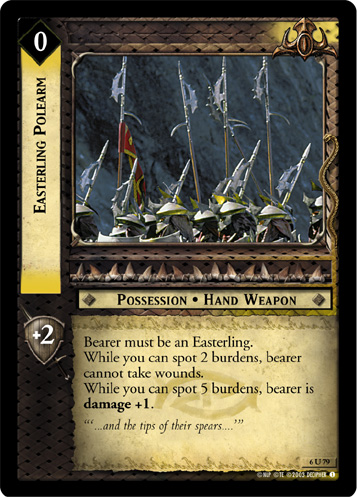
Rainbow Wounding has two bad matchups, and, unfortunately, one of them is very common in Movie Block.
Ninja Gollum is a problem. Ninja Gollum plays almost exclusively high-vitality minions: Shelob, Her Ladyship (10R23)
 and various versions of Gollum, occasionally with splashable hate minions that it recurs over and over. Rainbow Wounding has a lot of trouble chewing through fat Enduring minions like Shelob, and is often vulnerable to hate like Gríma, Chief Counselor (5R51)
and various versions of Gollum, occasionally with splashable hate minions that it recurs over and over. Rainbow Wounding has a lot of trouble chewing through fat Enduring minions like Shelob, and is often vulnerable to hate like Gríma, Chief Counselor (5R51)
 or Úlairë Enquëa, Lieutenant of Morgul (1U231)
or Úlairë Enquëa, Lieutenant of Morgul (1U231)
 (which it recurs repeatedly with Evil-smelling Fens (5U22)
(which it recurs repeatedly with Evil-smelling Fens (5U22)
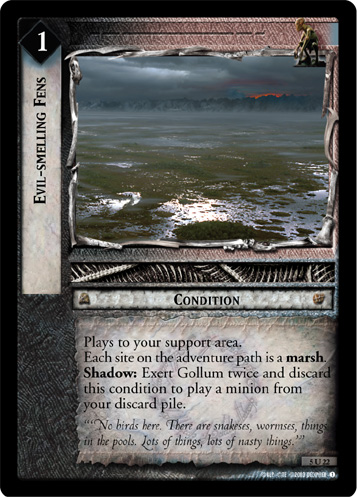 ). It's possible to beat Ninja Gollum: you need a plan for when your main trouble-shooting skirmisher—usually Lady of Ithilien or Sméagol, Always Helps—gets excluded by Her Ladyship, you'll need a plan to defang They Stole It (6R46)
). It's possible to beat Ninja Gollum: you need a plan for when your main trouble-shooting skirmisher—usually Lady of Ithilien or Sméagol, Always Helps—gets excluded by Her Ladyship, you'll need a plan to defang They Stole It (6R46)
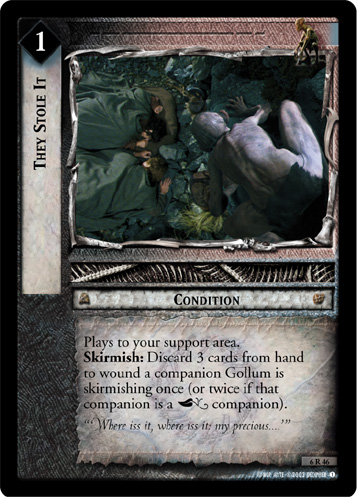 and Promise Keeping (8R24)
and Promise Keeping (8R24)
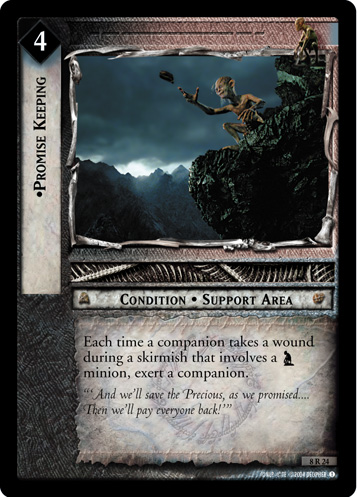 , and you'll definitely need a plan like Slaked Thirsts (7U14)
, and you'll definitely need a plan like Slaked Thirsts (7U14)
 or Shadowplay (10U114)
or Shadowplay (10U114)
 to stop hate minions. Any decent tank companion can usually handle Shelob on turns where Lady of Ithilien/Always Helps can't, and Secret Sentinels (2R20)
to stop hate minions. Any decent tank companion can usually handle Shelob on turns where Lady of Ithilien/Always Helps can't, and Secret Sentinels (2R20)
 or Deep in Thought (3C30)
or Deep in Thought (3C30)
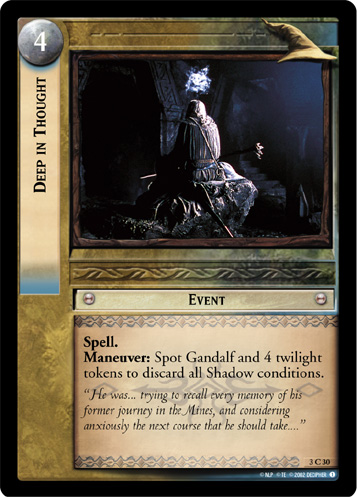 can handle the conditions. This is always going to be one of your hardest matchups, though.
can handle the conditions. This is always going to be one of your hardest matchups, though.
The other bad matchup is Beasterlings. Easterling decks almost always run Easterling Polearm (6U79)
 , often on a huge awful Fierce minion like Easterling Captain (4R225)
, often on a huge awful Fierce minion like Easterling Captain (4R225)
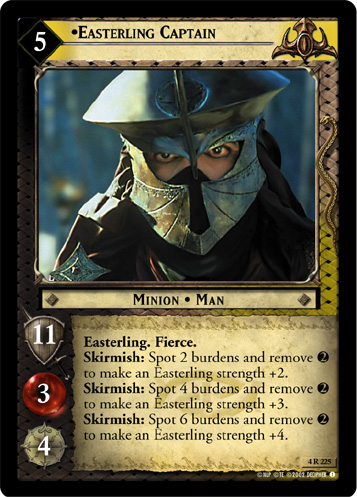 , often with a Raider Bow (7C155)
, often with a Raider Bow (7C155)
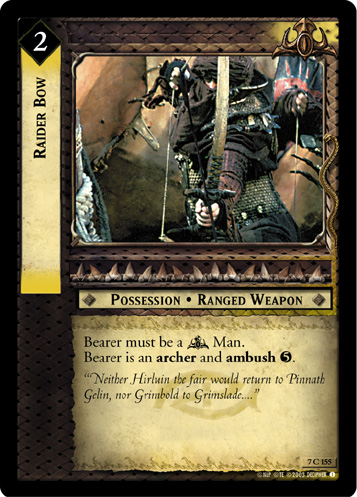 . You need a very strong tank to deal with this, or else you'll need to discard the Easterling Polearm or simply bypass the Easterling Army turns with some sort of trick. Aragorn with Andúril, Flame of the West (7R79)
. You need a very strong tank to deal with this, or else you'll need to discard the Easterling Polearm or simply bypass the Easterling Army turns with some sort of trick. Aragorn with Andúril, Flame of the West (7R79)
 and The Last Alliance of Elves and Men (1R49)
and The Last Alliance of Elves and Men (1R49)
 or Éomer, Third Marshal of Riddermark (4R267)
or Éomer, Third Marshal of Riddermark (4R267)
 (if you can exhaust the minion first) can often tank the hits, but be wary of Discovered (4R223)
(if you can exhaust the minion first) can often tank the hits, but be wary of Discovered (4R223)
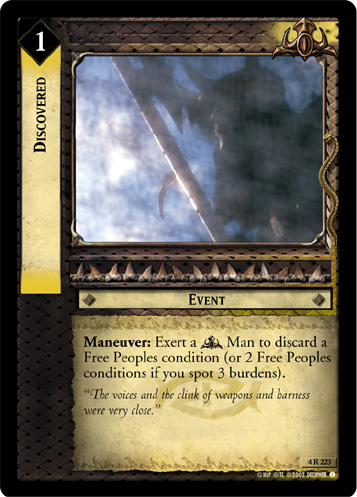 . Gandalf with Roll of Thunder (4U99)
. Gandalf with Roll of Thunder (4U99)
 or Eowyn with Éowyn's Shield (8R88)
or Eowyn with Éowyn's Shield (8R88)
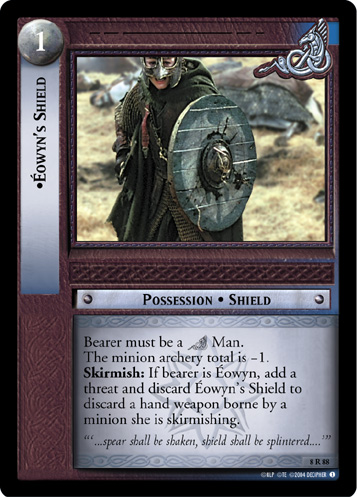 can remove the Polearm. Dwarven Armor (1C8)
can remove the Polearm. Dwarven Armor (1C8)
 can sometimes get Gimli through it, Gandalf's Staff (2R22)
can sometimes get Gimli through it, Gandalf's Staff (2R22)
 can fend it off at a high cost, and Rohirrim Helm (5R89)
can fend it off at a high cost, and Rohirrim Helm (5R89)
 (ideally recurred mid-skirmish with Merry, Swordthain (7R321)
(ideally recurred mid-skirmish with Merry, Swordthain (7R321)
 ) can deal with one turn. This is a rough matchup, but luckily the deck is fairly rare.
) can deal with one turn. This is a rough matchup, but luckily the deck is fairly rare.
There are a few other Shadow decks that can make minions (mostly or conditionally) immune to direct wounding as well. Most of the other similar Shadow cards don't protect minions during the skirmish phase, so Lady of Ithilien, Don't Look At Them, and the Frodo-signet wounding get free rein. Broad-bladed Sword (4C142)
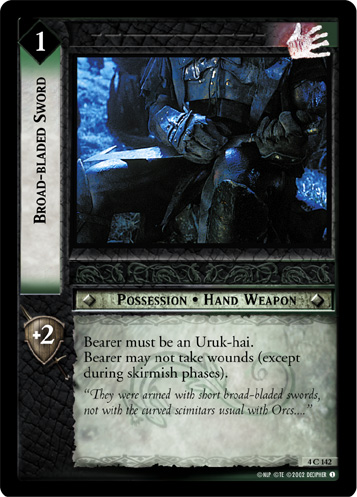 , High Vantage (10U44)
, High Vantage (10U44)
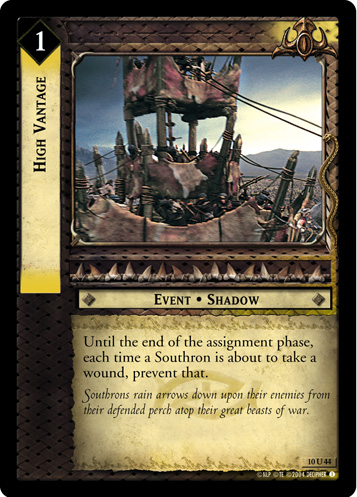 , and Line of Defense (8C63)
, and Line of Defense (8C63)
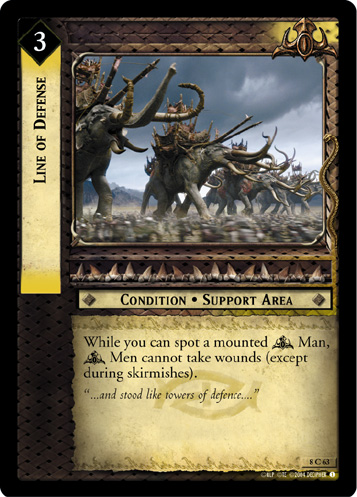 can all shut down archery (particularly Greenleaf) and most uses of Unheeded, but they're not too problematic in general. Broad-bladed Sword (4C142)
can all shut down archery (particularly Greenleaf) and most uses of Unheeded, but they're not too problematic in general. Broad-bladed Sword (4C142)
 or Isengard Warrior (3U61)
or Isengard Warrior (3U61)
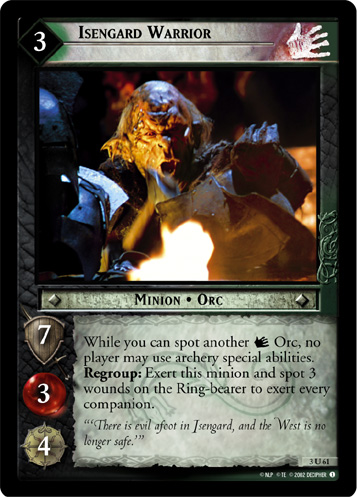 can be problematic in combination with Saruman's Snows (1C138)
can be problematic in combination with Saruman's Snows (1C138)
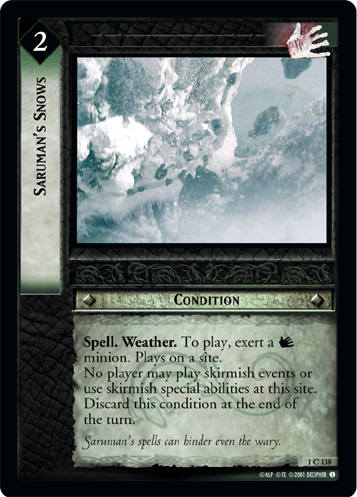 , but those cards are fortunately rare in Movie Block, and it's even possible to pick off the Isengard Warrior with Unheeded and either Slaked Thirsts or two copies of Shadowplay.
, but those cards are fortunately rare in Movie Block, and it's even possible to pick off the Isengard Warrior with Unheeded and either Slaked Thirsts or two copies of Shadowplay.
As mentioned with the Ninja Gollum matchup, silver bullet minions are often a problem. Rainbow Wounding decks often want to run a large rainbow Fellowship, which runs afoul of Gríma, Chief Counselor (5R51)
 or Úlairë Enquëa, Lieutenant of Morgul (1U231)
or Úlairë Enquëa, Lieutenant of Morgul (1U231)
 . Slaked Thirsts or (ideally multiple copies of) Shadowplay can defang those two minions and most similar rainbow/rule of 6 hate in other cultures. Shotgun Enquea can also be mitigated with Shoulder to Shoulder (1C59)
. Slaked Thirsts or (ideally multiple copies of) Shadowplay can defang those two minions and most similar rainbow/rule of 6 hate in other cultures. Shotgun Enquea can also be mitigated with Shoulder to Shoulder (1C59)
 , by transferring the wounds he applies as he applies them to keep him from killing anyone. Just be careful of Southrons: they can run Southron Leader (7R166)
, by transferring the wounds he applies as he applies them to keep him from killing anyone. Just be careful of Southrons: they can run Southron Leader (7R166)
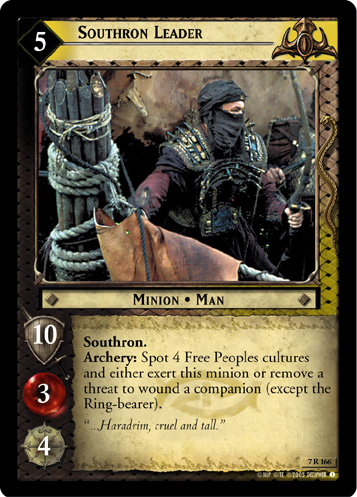 , Southron Commander (4U249)
, Southron Commander (4U249)
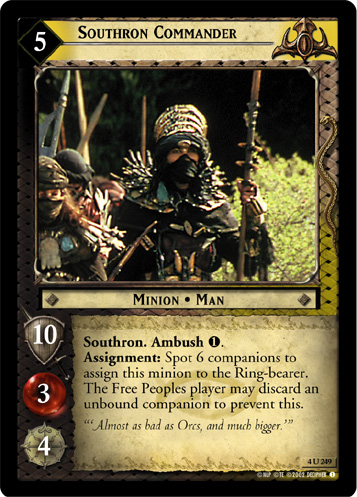 , and Southron Veterans (4R257)
, and Southron Veterans (4R257)
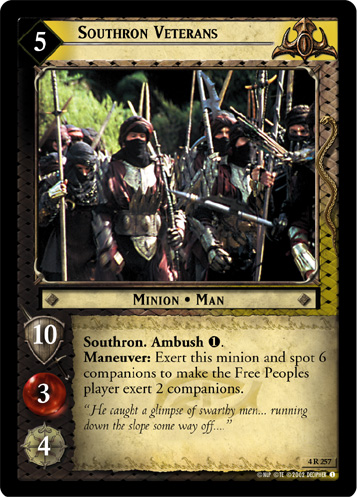 , and like Ninja Gollum they can recur them repeatedly, this time with Ships of Great Draught (8R65)
, and like Ninja Gollum they can recur them repeatedly, this time with Ships of Great Draught (8R65)
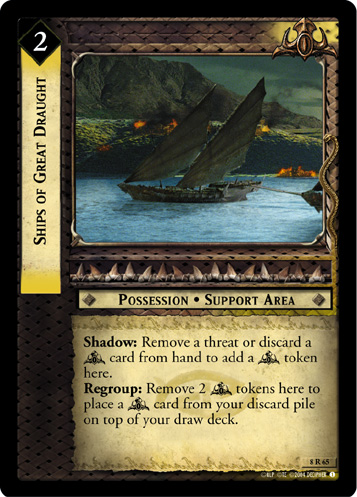 .
.
Speaking of Southrons, archery and direct wounding Shadows will check how good your healing is. Archery/grind decks, be they Sauron Grind or Moria Archery or Southron Archery or Uruk Archery, all pose basically the same challenge: can you outheal the damage they do every turn? Elven healing, The Shire Countryside (3R113)
 , or bouncing hobbits are all strong defenses against these grind Shadows. It's also helpful to avoid leaving characters exhausted, so they can't be picked off with Hate (1R250)
, or bouncing hobbits are all strong defenses against these grind Shadows. It's also helpful to avoid leaving characters exhausted, so they can't be picked off with Hate (1R250)
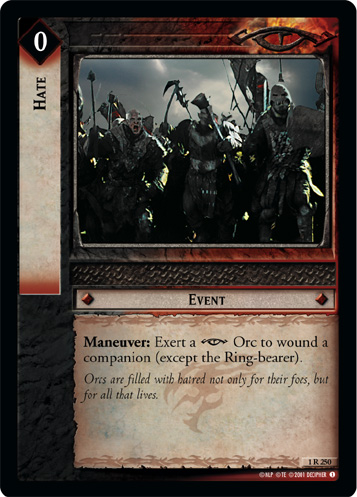 , Whirling Strike (4C260)
, Whirling Strike (4C260)
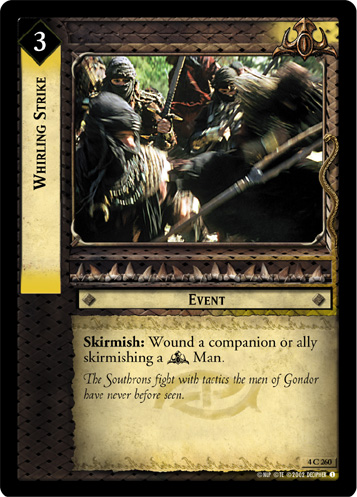 , or Caradhras Has Not Forgiven Us (1R123)
, or Caradhras Has Not Forgiven Us (1R123)
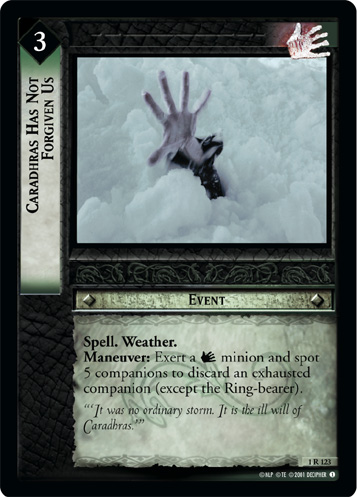 . Condition removal, usually from Elven
. Condition removal, usually from Elven
 or
or Gandalf cultures, is also helpful, since all of these decks rely on key conditions to do damage.
Another common Shadow strategy that can often give you fits is putting conditions on your key characters. Desperate Defense of the Ring (1R244)
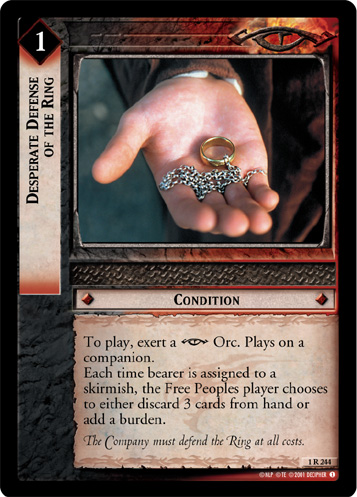 , Black Breath (1U207)
, Black Breath (1U207)
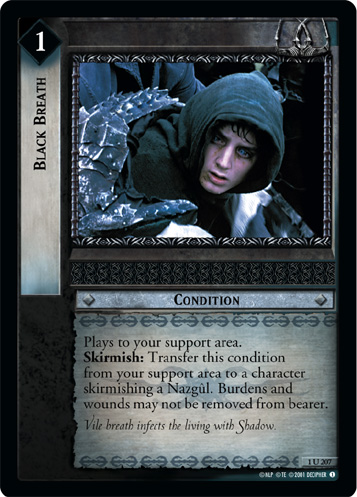 /Black Dart (8U69)
/Black Dart (8U69)
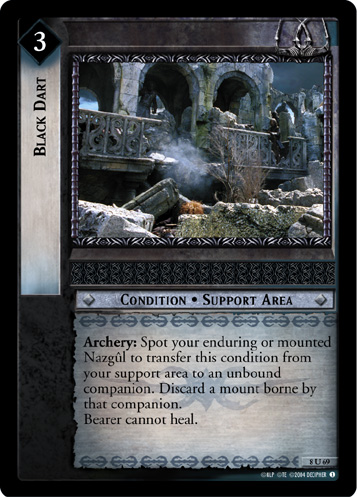 , and Weary (4C212)
, and Weary (4C212)
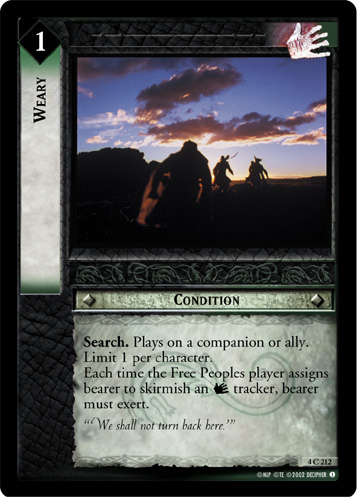 can all be a huge pain if they're dropped on the wrong character at the right time. Other than strong condition removal or possibly Athelas (1U94)
can all be a huge pain if they're dropped on the wrong character at the right time. Other than strong condition removal or possibly Athelas (1U94)
 , the best defense against these cards is simply to have a plan that can deal with minions without always using Lady of Ithilien or Sméagol, Always Helps. This is similar to the Ninja Gollum matchup, except that in a pinch you can still get some use out of those companions.
, the best defense against these cards is simply to have a plan that can deal with minions without always using Lady of Ithilien or Sméagol, Always Helps. This is similar to the Ninja Gollum matchup, except that in a pinch you can still get some use out of those companions.